
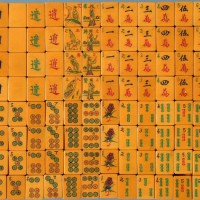
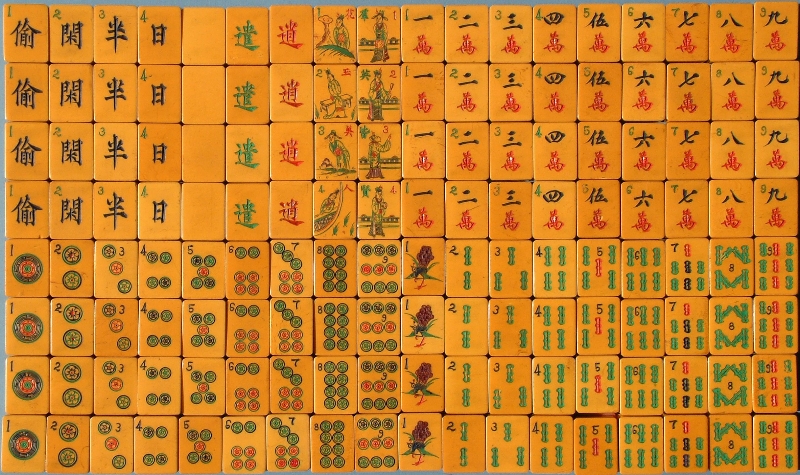
These tiles are backed with a pink wafer. This tile set has a feature that appeared quite early on in tile set development - namely, the Directions and Honours/'Dragons' have been substituted with tiles bearing different sinograms. (see Mah Jong(g), Before and After Mah Jong(g) Part 2). Starting from the left we have; tou 'steal', xian 'idleness' = touxian = "enjoy occasional leisure in a busy life", ban 'in the middle', ri 'day'. Thus we have "enjoy occasional leisure in a busy life during the middle of the day'. From the left the substitute Honours/'Dragons' are; qian 'send', xiao 'leisure' = qianxiao = amusement, fun or game. all together we have; tou xian ban ri qian xiao = "enjoy an occasional, leisurely, fun game in the middle of a busy day". The Flowers/Seasons tiles are decorated with human figures in traditional dress. The left quartet reads; hua 'flower'; yu 'jade'; mei 'beautiful'; ren 'person' = "a beautiful woman is like a jade flower". The right quartet reads; qun 'group'; ying 'hero'; jie 'very'; xian 'virtuous' = "all men are capable heroes".
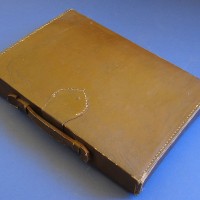
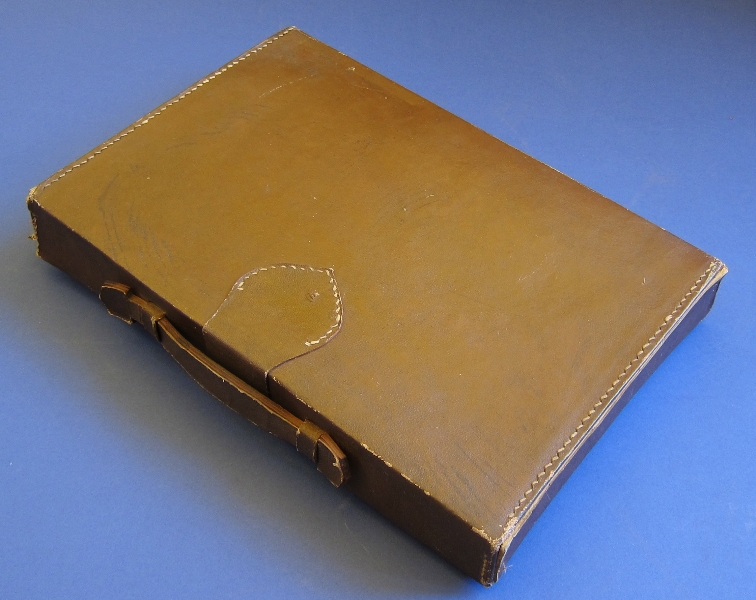
Attaché style case with thick leather stiched over a cardboard frame. Five red-lined felt trays inside, four for tiles and one for accessories.
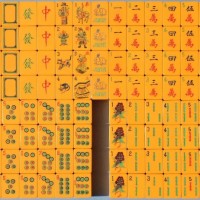
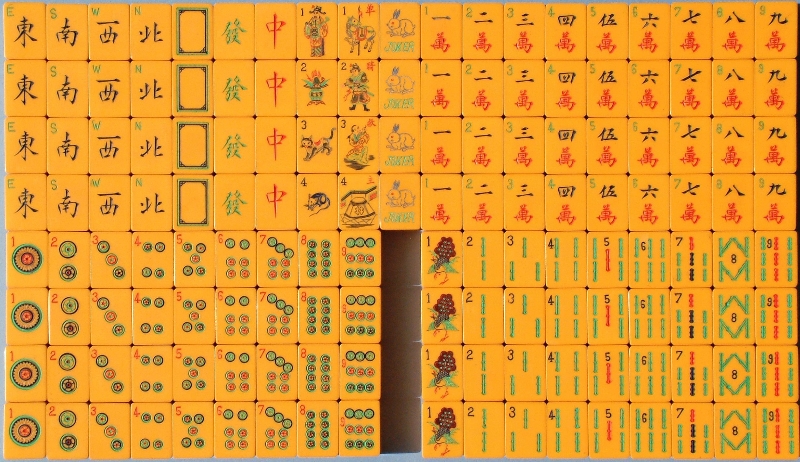
Tile set displaying four Jokers. The Flowers/Seasons left quartet are the usual 'rich man; a crucible of gold; a cat and a rat; Thus the rich man attains wealth and the cat catches a rat. The right quartet reads; dan 'one, single, only'; qi 'ride (a horse)'; jiu 'rescue, save, salvage'; zhu 'owner, master'. Thus dan qi jiu zhu = "save the master with one horse" (one who saves his master by himself is very brave).
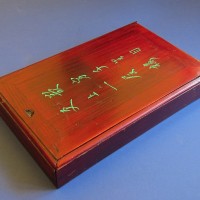
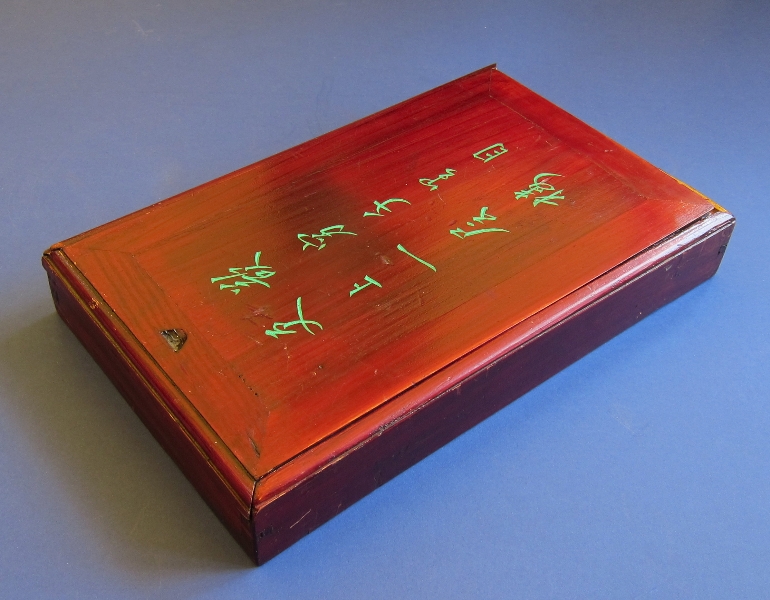
Red-stained, slide-top box with a slide-top lid. Ten reen sinograms carved into the lid in a 'cursive' script.
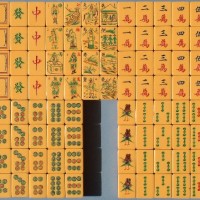
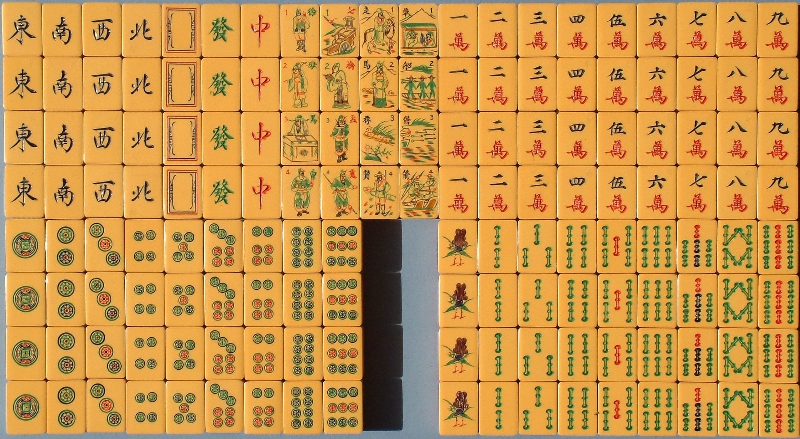
A tile set of one hundred and fifty six tiles. Sixteen of which are Flowers/Seasons. Note the framed white Honours/'Dragons' tiles plus the use of a geometric figure in the one Cash/'Circles'. Typically, for these sets, the three suits' symbols are engraved with decorated features. See the following pictures for the Flowers/Seasons.
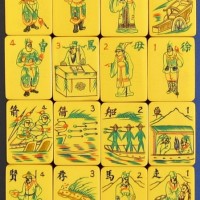
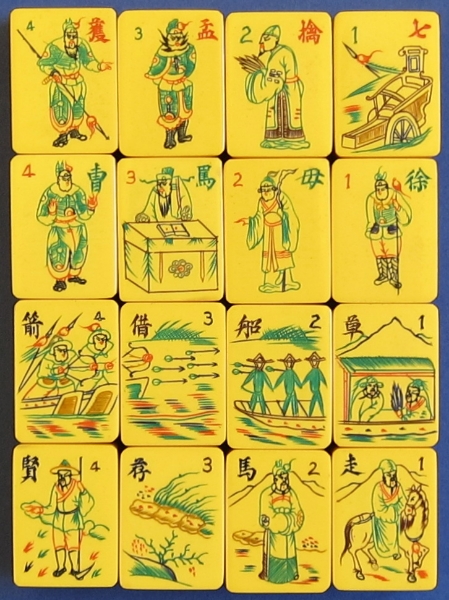
These tiles reference stories from the 'Three Kingdoms' period of Chinese history (second and third centuries AD). The period is most remembered by a fifteenth century novel "Romance of the Three Kingdoms". The tiles in their rows have been placed in their correct orientation. Thus, row one reads, from right to left; qi 'seven'; qin 'capture'; meng 'meng'; huo 'huo' = qi qin meng huo = "the seventh capture of Meng Huo" (The Three Kingdoms. Chapter 90). The second row reads; xu 'xu'; mu 'mother'; ma 'scold'; cao 'cao' = xu mu ma cao = "Xu Shu's mother disparages Cao Cao". (The three Kingdoms. Chapter 37). The third row reads; cao 'grass or straw?'; chuan 'boat'; jie 'borrow, make use of'; jian 'arrow' = cao chuan jie jian = "Borrow a boat and make use of straw men (against) arrows". I think this is a good interpretation since the figures in the back of the boat are Straw Men. (The Three Kingdoms. Chapter 46). The fourth row reads; zou 'walk'; ma 'horse'; jian 'recommend for a post'; xian 'virtuous, able'. The phrase 'jian xian' appears only once in the novel (The Three Kingdoms. Chapter 120) and translates as 'bring good people into prominence' - in the novel Sima Yan said, "how beautiful it is to bring good people into prominence!". However, there is no indication as to what 'walk/horse' might mean, although in the name 'Sima', 'ma' means horse. To extrapolate widely we might therefore have "Sima travels to bring good people into prominence".
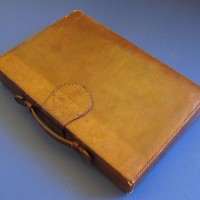
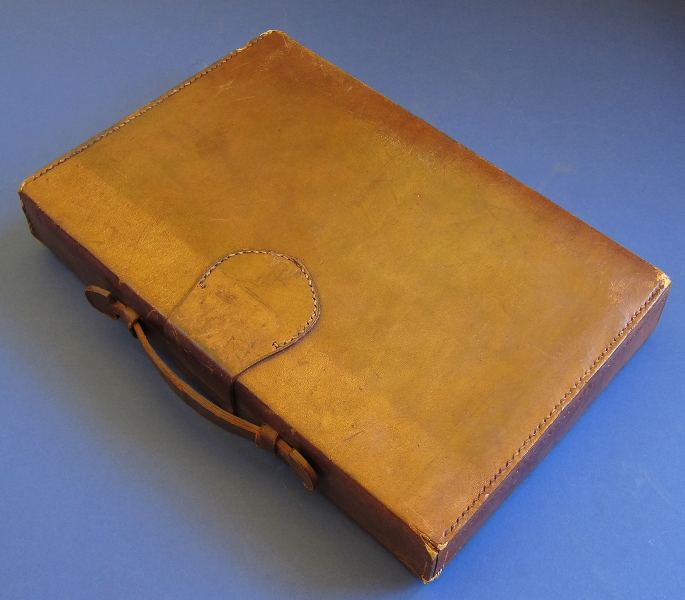
Attaché style case made of leather stitched over a cardboard frame. Five felt-lined trays for tiles and accessories.
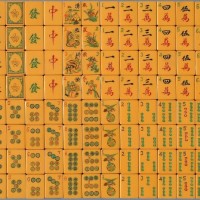
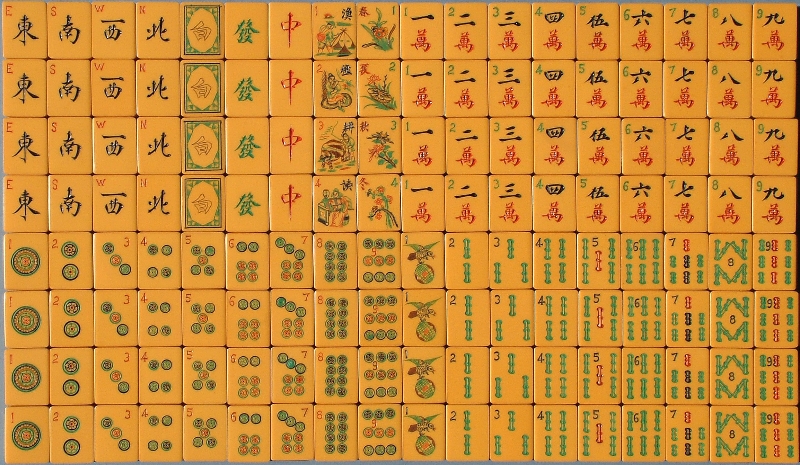
This set has another motif commonly found on the one SoC/'Bamboo' - a bird in flight over a globe with what appear to be latitude and longitude lines, usually with a red patch in the middle. This red patch may be a reference to the 'middle kingdom' - China. The white Honours/'Dragon' tiles are decorated with an ornate frame with the sinogram for bai, 'white'. The Flowers/Seasons also sport a common combination of motifs. The left quartet reads; yu 'to fish' = 'fisherman'; qiao 'firewood, woodman' = 'woodcutter'; geng 'plough' = 'farmer'; du 'read' = 'scholar'. These are the 'four callings of mankind'. The right quartet reads; chun 'Spring'; xia 'Summer'; qiu 'Autumn' and dong 'Winter'. There flowers are; narcissus? = 'married couple'; lotus flower bud and leaf = 'concord, happy union', chrysanthemum = 'long life' and plum tree? = many children' = "may you as a married couple have a happy union with a long life and many children".
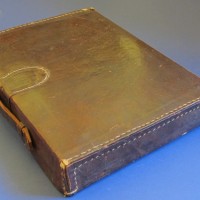
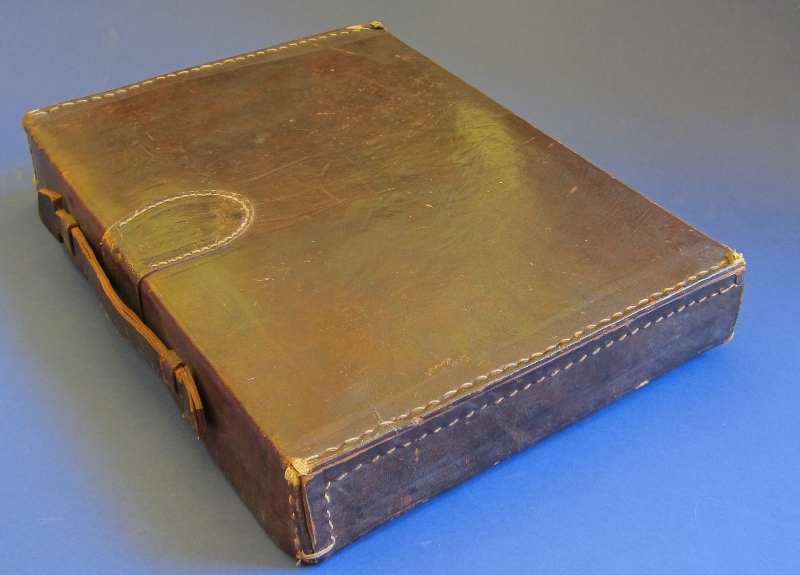
Dark brown attaché-style case made of leather stitched over a cardboard frame. Five felt-lined trays for the tiles and accessories.
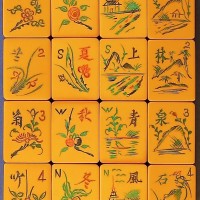

16 'Flowers';
1st column (left hand);
The usual flowers
#1, 梅, Mei, Plum
#2, 蘭, Lan, "Orchid". The simplified character has been used on the tile, 兰.
#3, 菊, Ju, "Chrysanthemum"
#4, 竹, Zhu, "Bamboo"
2nd column;
The Four Seasons;
#1, 春, Chun, "Spring"
#2, 夏, Xia, "Summer"
#3, 秋, Qiu, "Autumn"
#4, 冬, Dong, "Winter"
3rd column;
#1, 江, Jiang, "River"
#2, 上, Shang, "Above"
#3, 青, Qing, "Green" or "blue"
#4, 風, Feng, "Wind"
This would need to translate to "the wind above the green river" but the word order isn't quite right. The tiles actually say "the green wind above the river" which doesn't make sense. These characters have occurred on other sets but with 清, also pronounced Qing, meaning "Clear", as the third tile's character, which makes much more sense! The intention may have been to have this meaning rather than 青, Qing, "green".
If we assume this meaning, we get a translation as "the clear wind above the river".
This probably comes from Su Shi's poem "Former Ode to the Red Cliffs" which includes the lines...
"Only the clear wind on the river, and the bright moon between the mountains: the ear receives one and creates sound, the eye meets the other and makes color; you can take these without prohibition, and use them without exhausting them. This is the infinite treasure of the Creator, and what you and I can share and rejoice in...".
Last column (right hand);
#1, 山, Shan, "Mountain"
#2, 林, Lin, "Forest"
#3, 泉, Quan, "Spring", as in "mountain spring"
#4, 石, Shi, "Stones" or "Rocks"
The word for spring, Quan, can also translate to "small and gentle stream". This leads to a couple of translations; (1) "The spring and rocks in the wooded mountain" or (2) "the small stream flows over rocks in the mountain forest". [Special thanks to Ray Heaton for column 2 and 3 translations.]
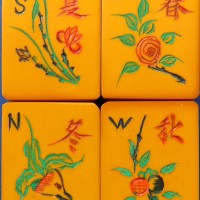
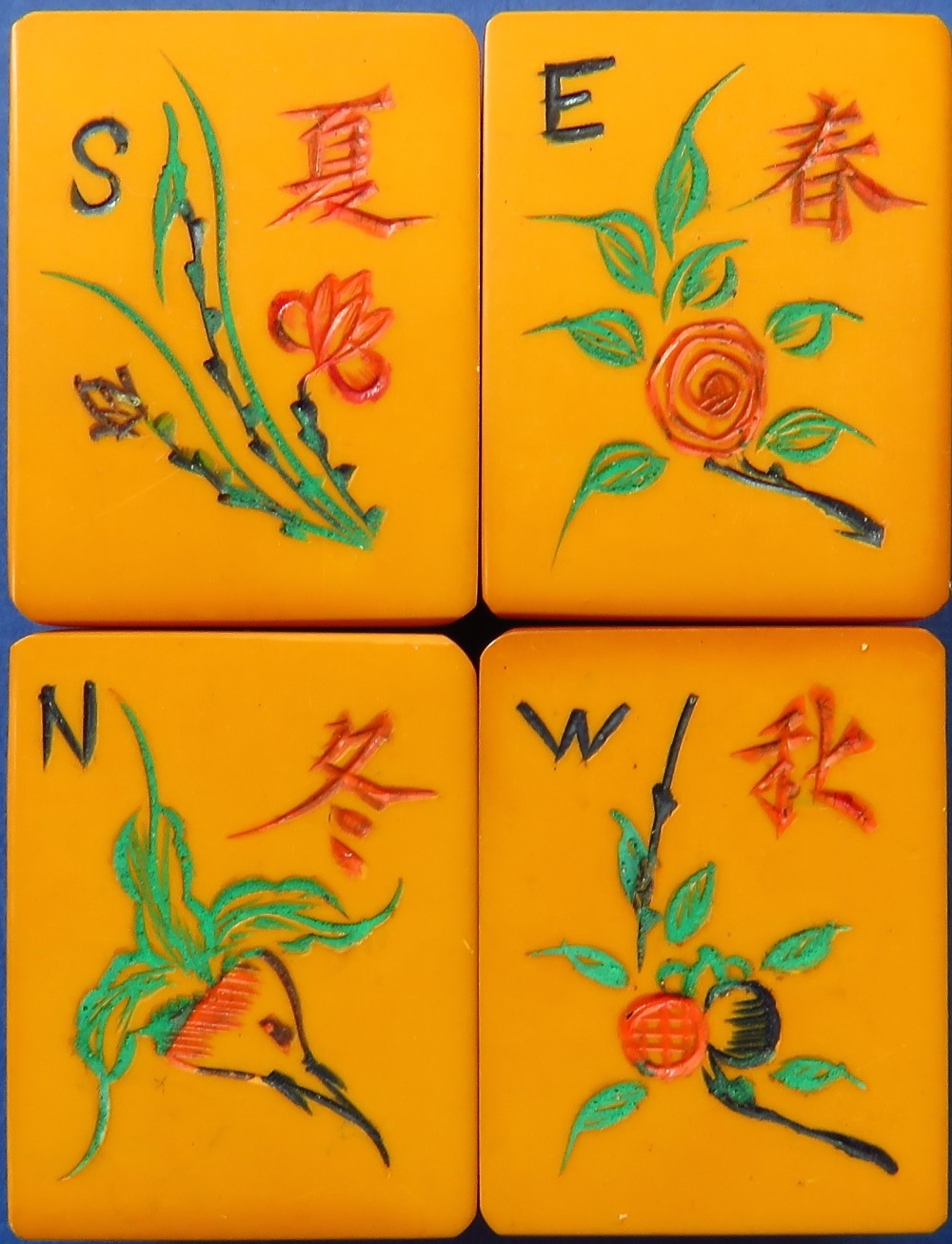
Although the sinograms are for the Four Seasons, the flowers together have a different meaning. On the East tile we have, most likely, the Rose, a symbol for 'Longevity'. On the South tile is a Lotus bud, leaf and flower, a symbol for 'Complete Union'. The West tile has the Pomegranate fruit exposing its seeds, a symbol for 'Many Children'(in the past it meant 'many sons') and on the North tile we have a Narcissus bulb, the narcissus being a symbol for a 'Married Couple'. Thus, we have "may you have a complete union with many children and a long marriage".
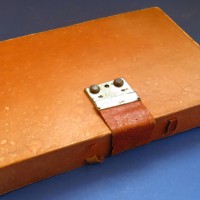
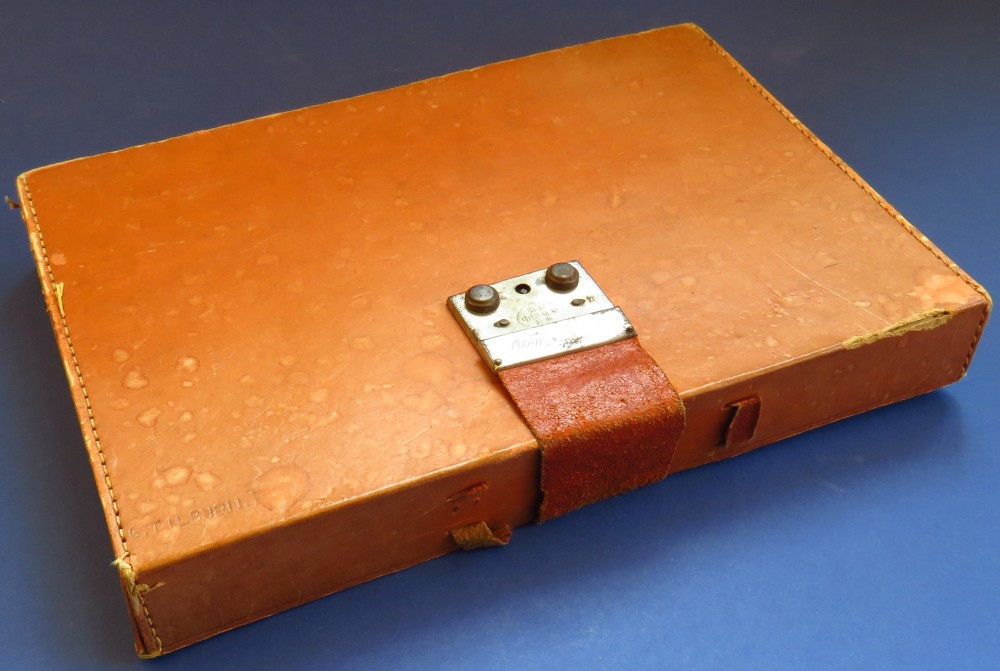
Leather lined cardboard attaché-style case with four felt trays and a fifth, narrow, felt tray t hold the set accessories.
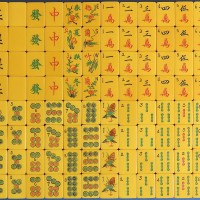
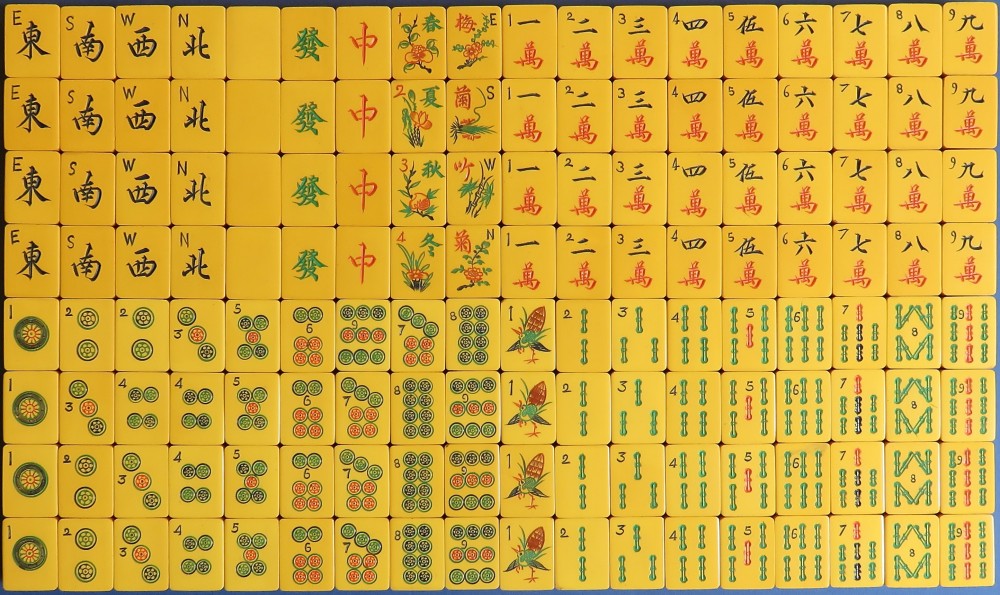
This is an example of a standard, engraved synthetic tile set sporting yellow tiles with, in this case, translucent green backing wafer. All the structural features of the Culin tile set are present. The composition of the tiles is still to be determined although their yellow appearance may be due to a dye or the effect of heat or oxidation or a combination of these.
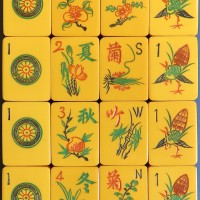
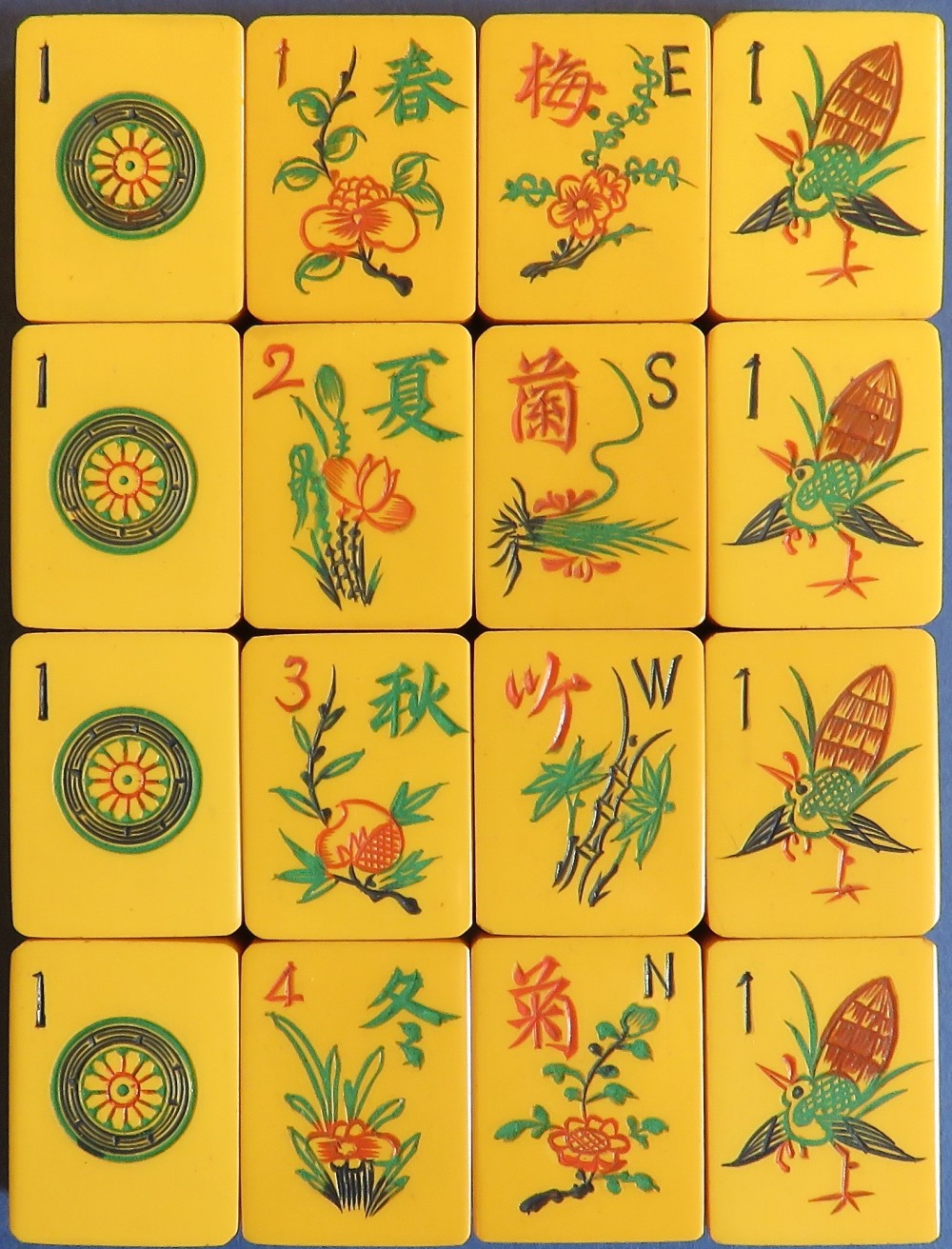
The Flowers/Seasons left quartet are the usual chun 'Spring', xia 'Summer', qiu 'Autumn' and dong 'Winter'. The plants are the peony (riches), lotus with blossom, bud and leaf (concord in marriage) pomegranate (many sons/children) and narcissus (married couple) = "may you have riches and a happy marriage with many children". The right quartet are li 'plum', lan 'orchid', zhu 'bamboo' and ju 'chrysanthemum' = the four noble plants. The plants are the same but note the orchid mistakenly engraved on its side.
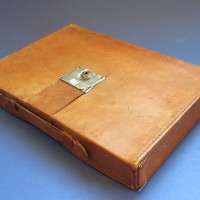
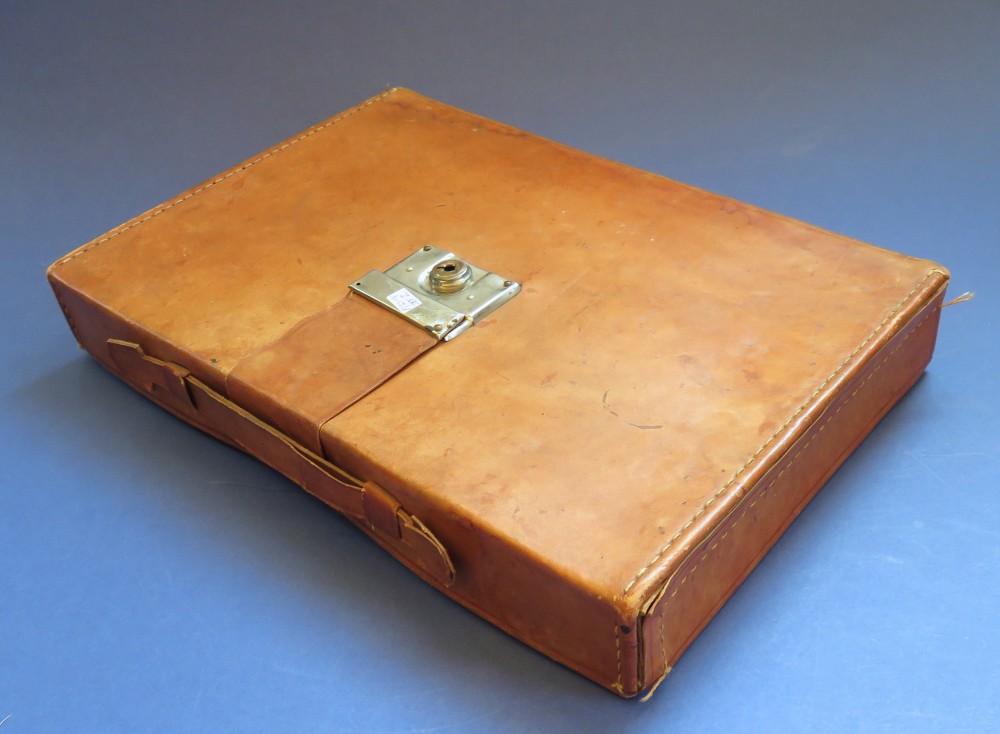
Attaché-style case made of thin leather stitched over a cardboard frame. Five felt-lined trays inside, four for the tiles and one thin central tray four the spare tiles and accessories.
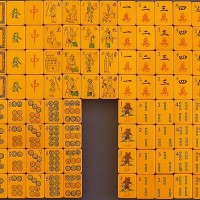
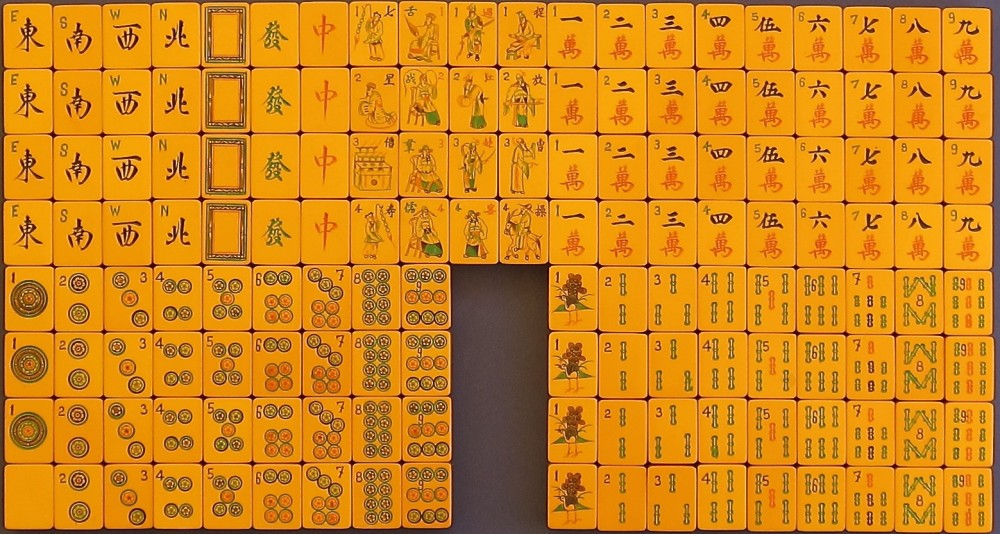
Another 16 Flowers synthetic set.
One tile missing. Ornately carved White Dragon frame and ornately engraved suit symbols.
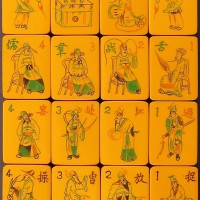

16 Flowers; Reading each row from 1 - 9;
Top row, 七星俉寿, Qi Xing Jie Shou, "Seven Stars Borrow Life". This is difficult to translate but the episode referred to is;
Wang Yun lent Cao Cao his Seven Starred Sword after Cao promised to assassinate Dong Zhuo. Cao Cao met Dong Zhuo in the latter's bedroom the following day and attempted to stab Dong with the sword just as Dong faced away. However, Dong Zhuo saw Cao Cao drawing his sword through a reflection in a mirror and immediately turned around to question Cao. Cao Cao sensed trouble and quickly knelt down, lying to Dong Zhuo that he intended to present the sword as a gift. Concurrently, Lü Bu had also returned after Dong Zhuo sent him to choose a new steed for Cao Cao, so Cao escaped from the capital Luoyang on the pretext of test-riding the horse.
2nd row, 舌战羣儒, She Zhan Qun Ru, "War of words", group, scholar. This has become a well known idiom, meaning "to win over a group of people through argument". This is taken from "Zhuge Liang Talking down a Group of Scholars".
Faced with imminent attack by Cao Cao's troops, Zhuge Liang traveled to the Wu State to lobby Wu officials to form an alliance against Cao Cao. At that time, most Wu officials were inclined to surrender to Cao Cao. With great courage and insight, Zhuge Liang had a heated debate with Wu officials and refuted their opinions one by one. His eloquence finally convinced Sun Quan, the King of the Wu State, who therefore agreed to form an alliance with Liu Bei to resist Cao Cao.
3rd row, 過江赴宴, Guo Jiang Fu Yan. "To cross the river to attend a banquet".
This part of the story is also known as "Guan Yu Goes To A Feast Alone".
These refer to an incident in the book when Sun Quan invited Guan Yu (one of the three sworn brothers in the story, and Sun Quan's enemy) across the river to a feast in the hope of trapping and killing him. Guan accepted the invitation, but was well aware that a trap was planned "...This has all come out of my refusal to yield those three territories...They are going to try coercion at this banquet. If I refuse, they will think I fear them....". Soldiers were lying in ambush near the banquet area, waiting for the signal to dash out and kill Guan Yu. Guan Yu wasn't fooled and took a hostage, only releasing him after safely boarding his vessel homeward.
4th row, 捉放曹操, Zhuo Fang Cao Cao, or "Capture, Release, Cao Cao.
Cao Cao fled from the capital Luoyang after failing to assassinate Dong Zhuo. Dong Zhuo ordered notices for Cao Cao's arrest to be put around the areas surrounding Luoyang. During his escape, Cao Cao was spotted in Zhongmu County by an official called Chen Gong and was arrested. Chen Gong had a private conversation with Cao Cao and decided to release the latter after being inspired by Cao's sense of righteousness. Chen Gong even gave up his official post and became Cao Cao's companion.
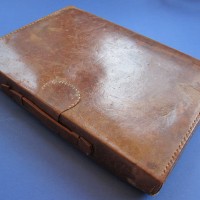
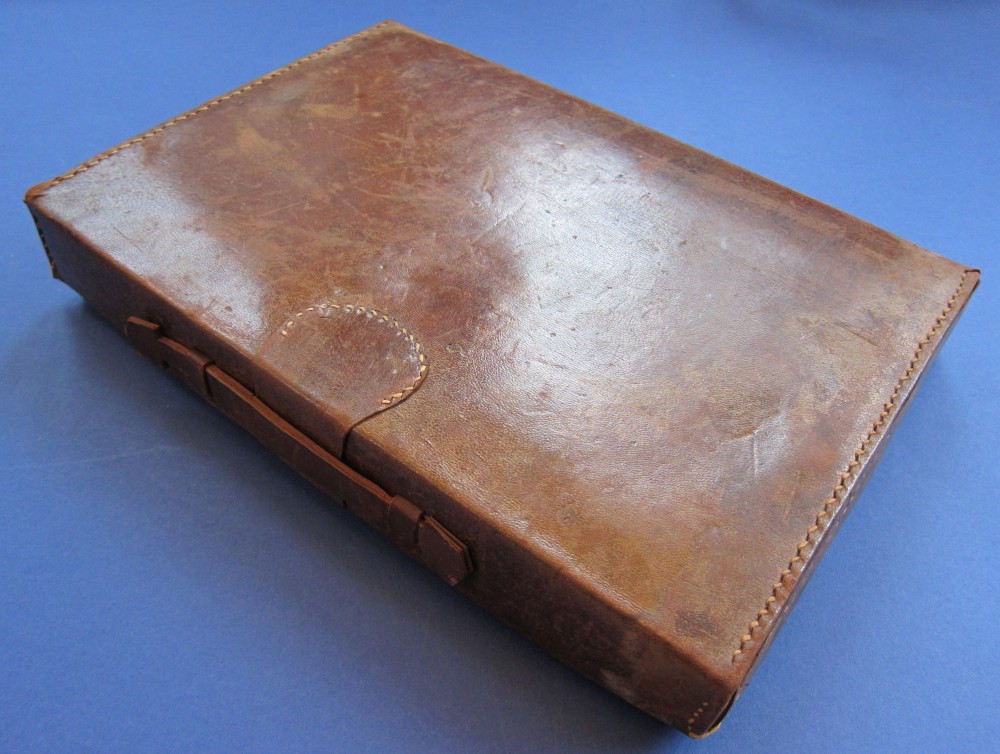
Leather over thick cardboard attaché-style case. Four felt-lined trays for the playing tiles with one thin felt-lined tray for the set accessories.
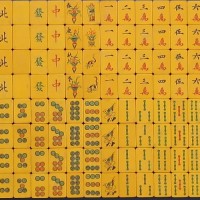
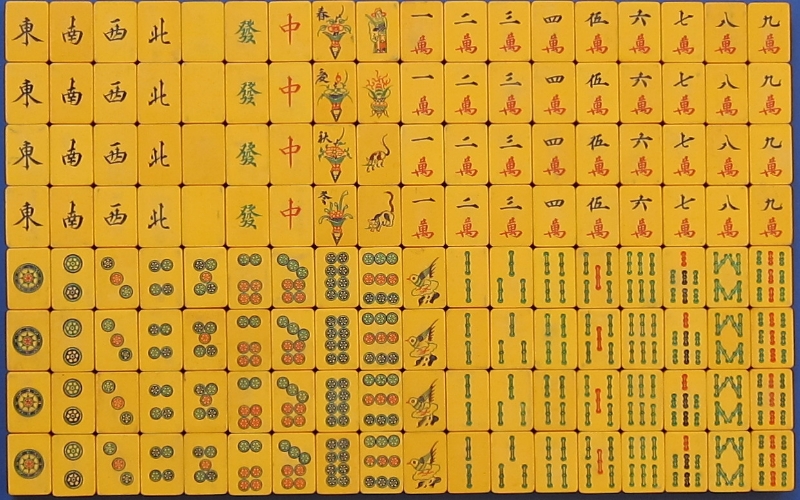
Ornately decorated suit tiles with the traditional form for wan 'myriads' (of Cash), Cash/'Circles' decorated with flowers and SoC/'Bamboo' rods decorated with round protuberances. No English letters or Arabic numerals. There is an unusual bird standing on what appars to be the 'herb of immortality'. The Flowers/Seasons left quartet are the Seasons; chun 'Spring'; xia 'Summer'; qiu 'Autumn' and dong 'Winter'. The plants in vases are the 'peony' (riches), lotus bloom, leaf and bud (concord), chrysanthemum (for a long time), narcissus (married couple) = "may you have riches and a happy marriage for a long time". The right quartet are the rich man attains a crucible of gold, the cat catches the rat. Tiles backed with a black wafer.
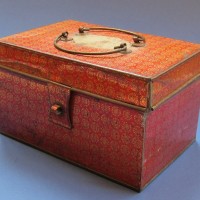
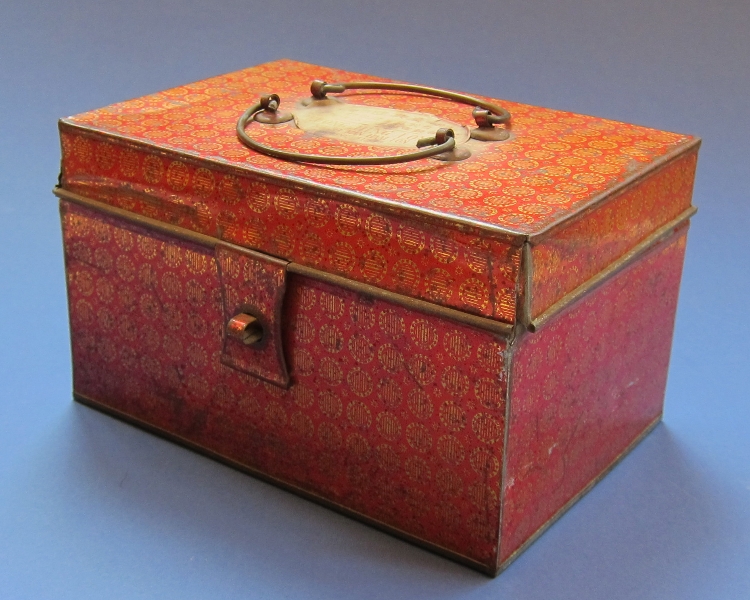
An example of a tin container. It has one tin tray inside that sits at the top and holds the accessories.
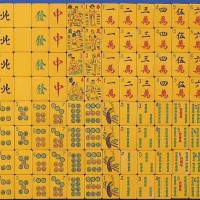
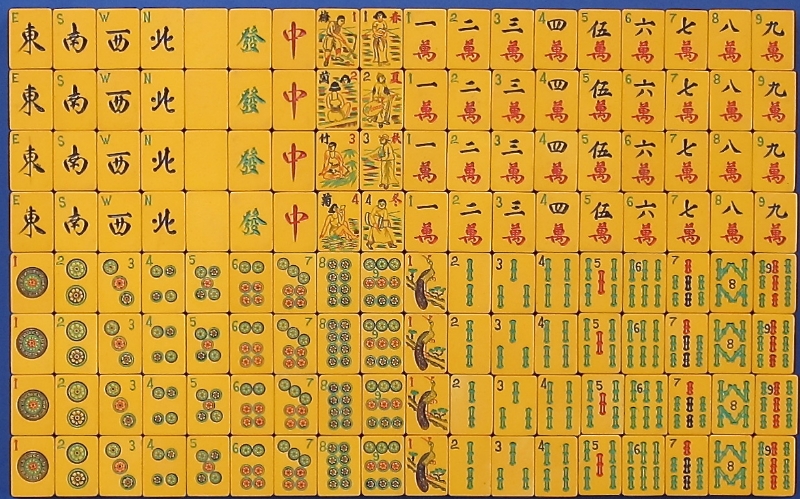
A good example of a set with the Culin set structure. Note the ornate engravings for the three suits and the use of a version of the bird commonly found standing on one leg on a stone with its neck turned backwards. In this case the bird is perched on a branch. The Flowers/Seasons show Chinese people in engaged in various activities. The fashion appears to show a 1920's - 30's style. The left quartet sinograms are the usual Four Noble Plants of plum, orchid, bamboo and chrysanthemum. The right are Spring, Summer, Autumn and Winter.
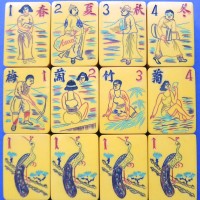
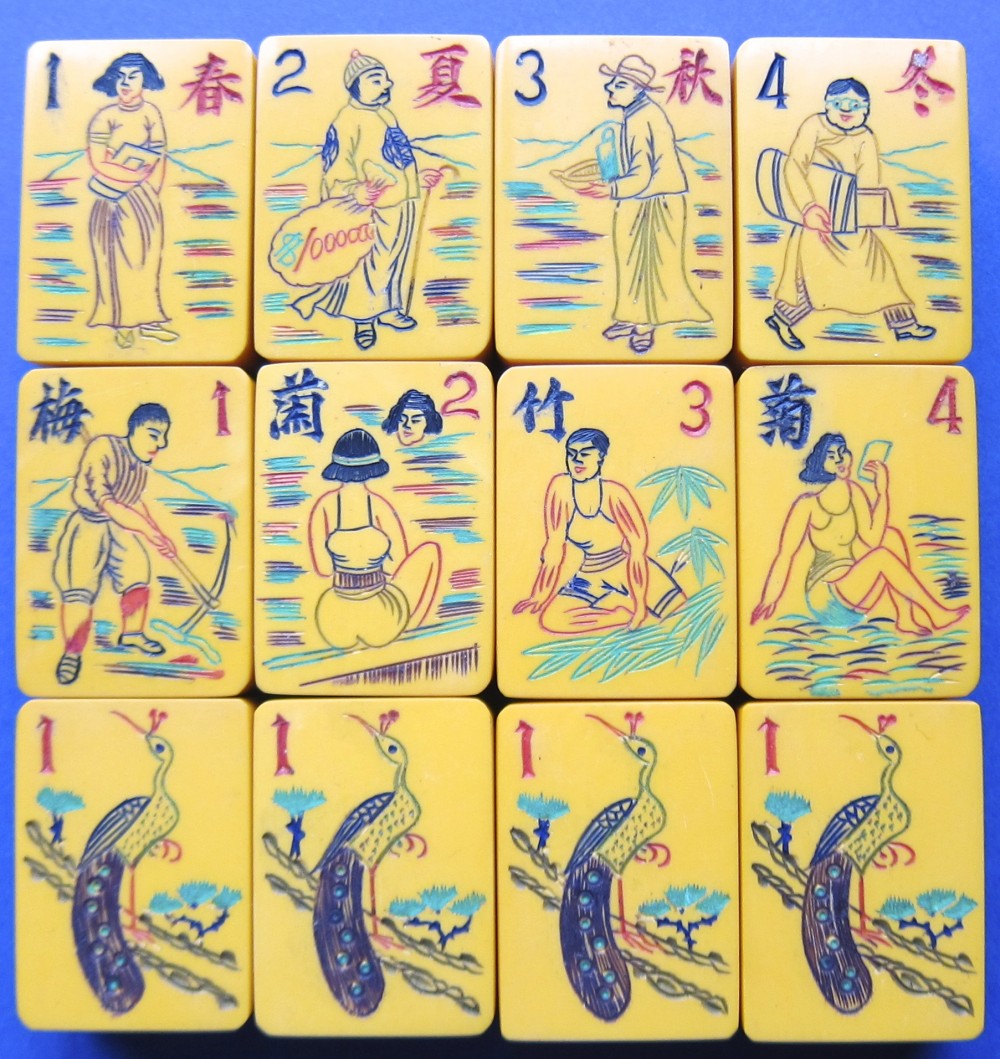
Close up of the Seasons (top row) and the Flowers (bottom row). Both rows show Chinese people in more contemporary (1930's) attire and pursuits.
Note also the bird. This type and pose, when reversed, is identical to the type of bird found in many flat boxed sets with sliding lids.
This may be a signal that some of this types of set originated much earlier - at the end of the 1930's, rather than the 1950's/60's. Other factors such as the make of the box and the type of symbols on the other tiles also play a part.
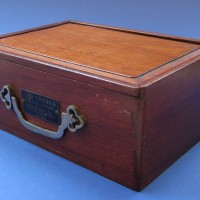
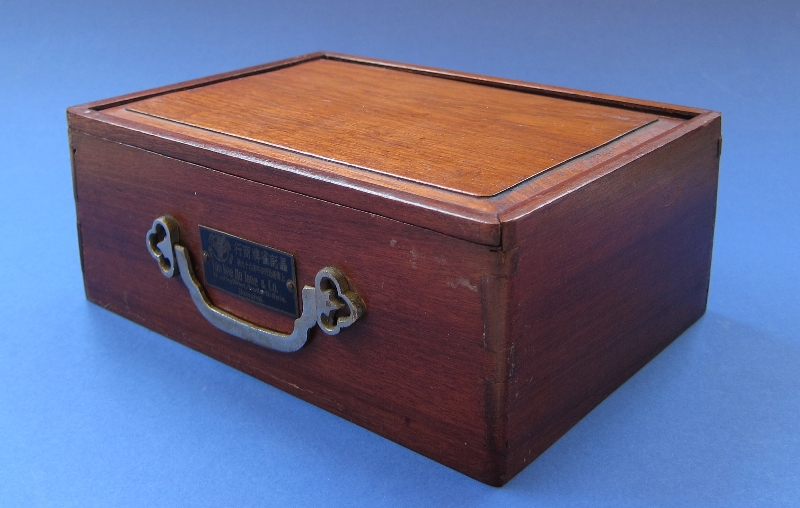
A slide-top wooden box with a handle on the side together with the makers metal plate. The lid slides out to the side of the box.
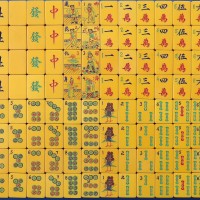
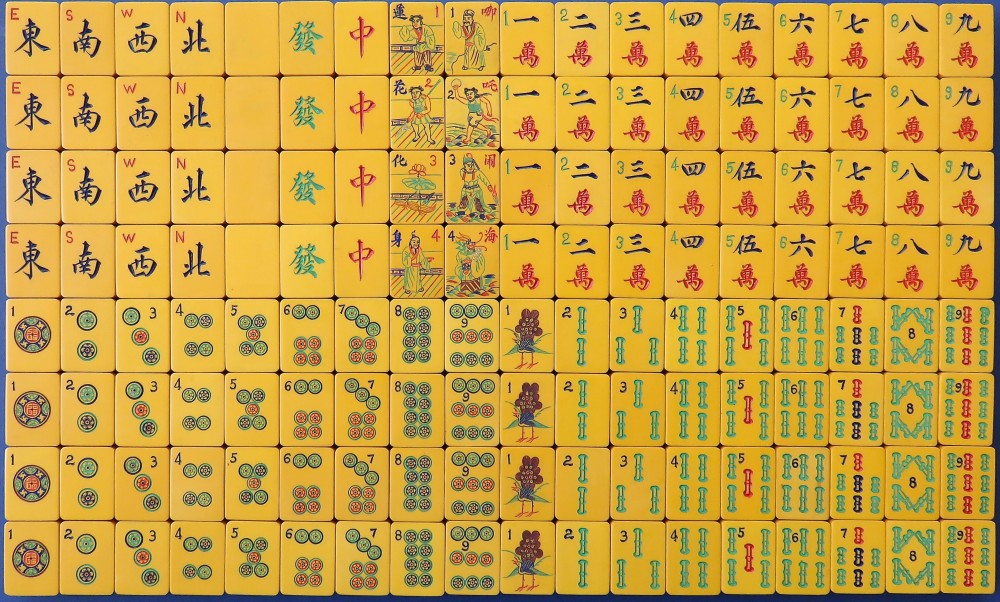
These tiles are backed with a green wafer. Similar in structure to the preceding set. Ornately engraved tiles. Note that the one Cash/'Circles' tiles are decorated with round sinograms at their centre. The Flowers/Seasons are decorated with human figures.
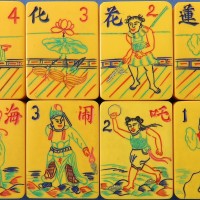
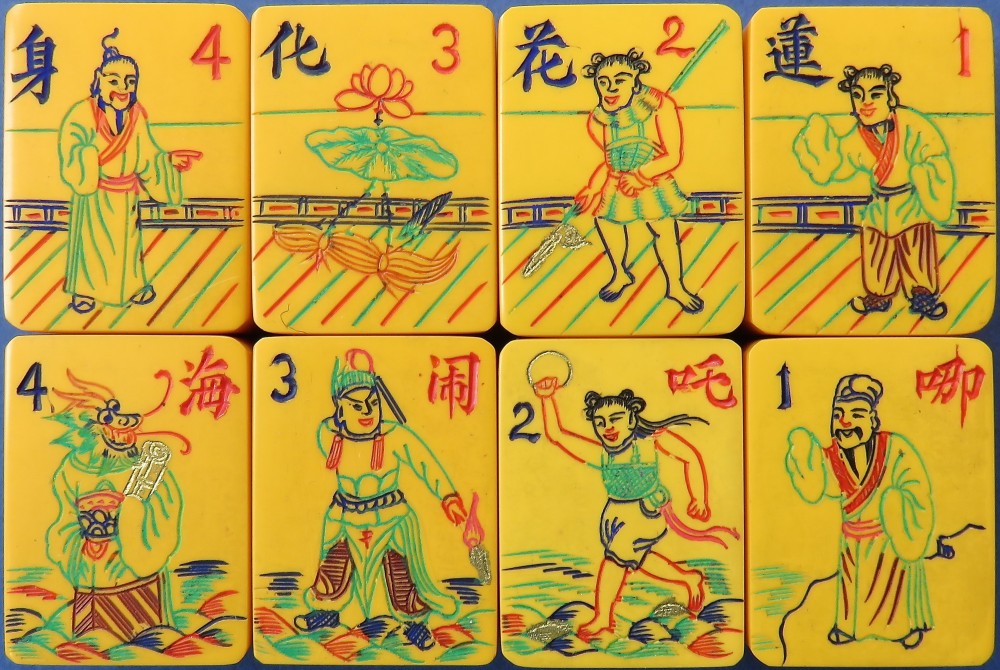
The top quartet reads (from right to left); lian 'lotus'; hua 'flower'; hua 'transform' and shen 'life' = "the lotus flower transforms life". The bottom quartet are difficult to translate(from right to left); na? 'which, what'?; chi? 'eat at, live on'; nao 'noisy, do, make, undertake'; hai 'big lake, great number of people' = ?.
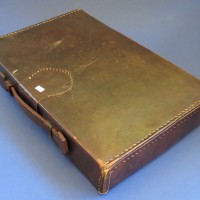
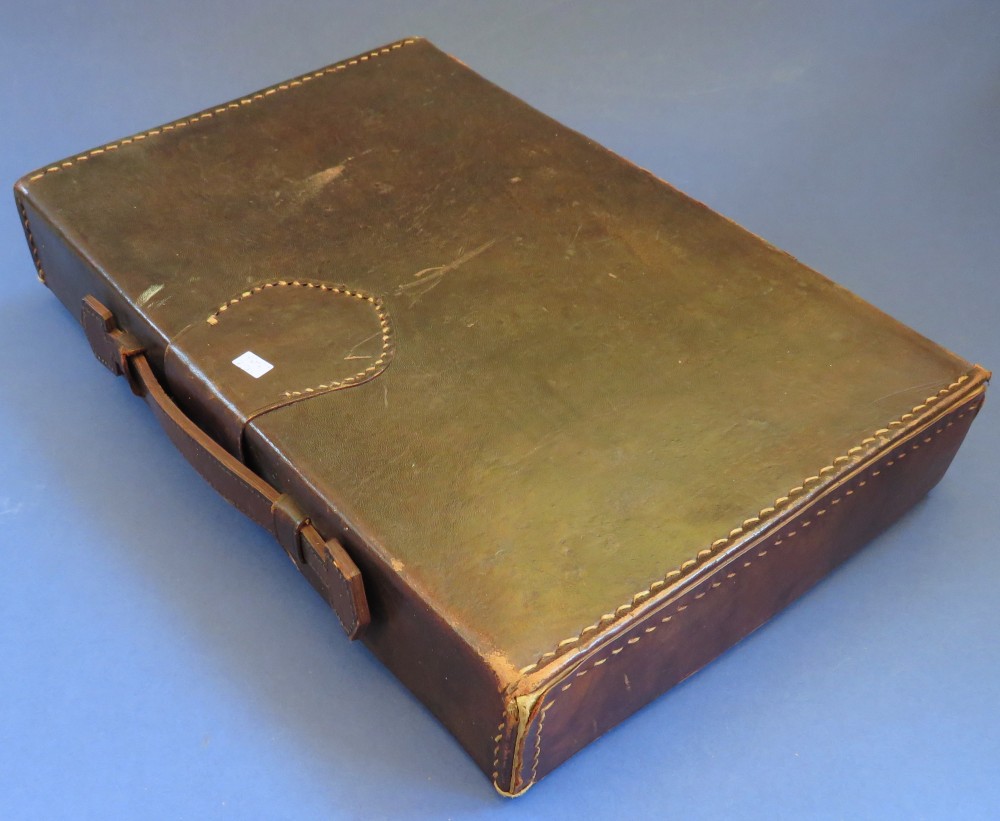
Attaché-style case made of leather stitched over a thick cardboard frame. Five green felt lined trays. Four for the tile groups and one narrow one for the accessories.
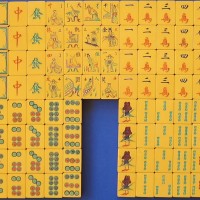
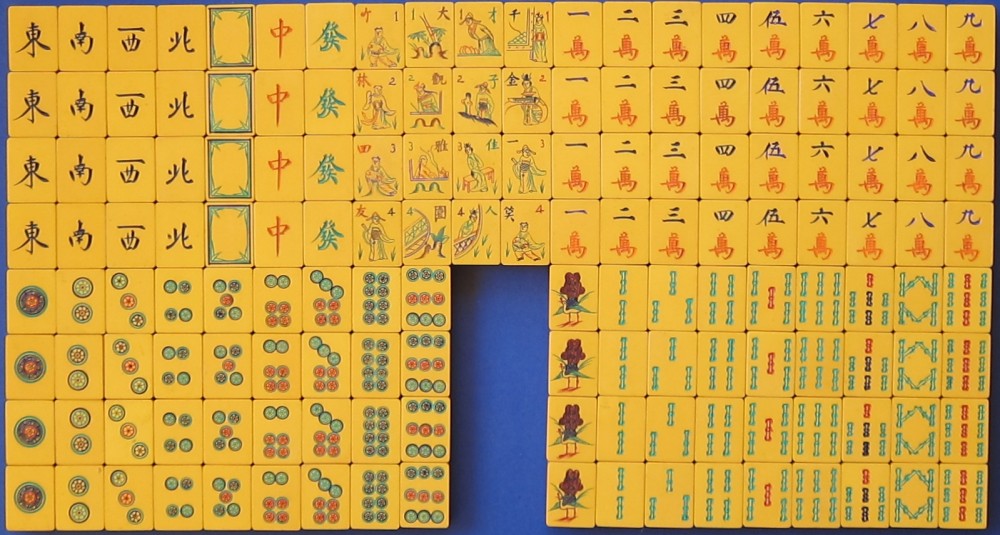
These tiles are backed with a red wafer.
16 Flowers synthetic set. The Flowers in this set are not based on the usual stories such as the 'Romance of the Three Kingdoms' for example, but are based on sayings(see next image).
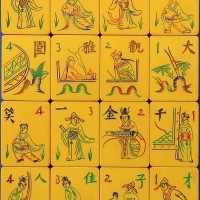
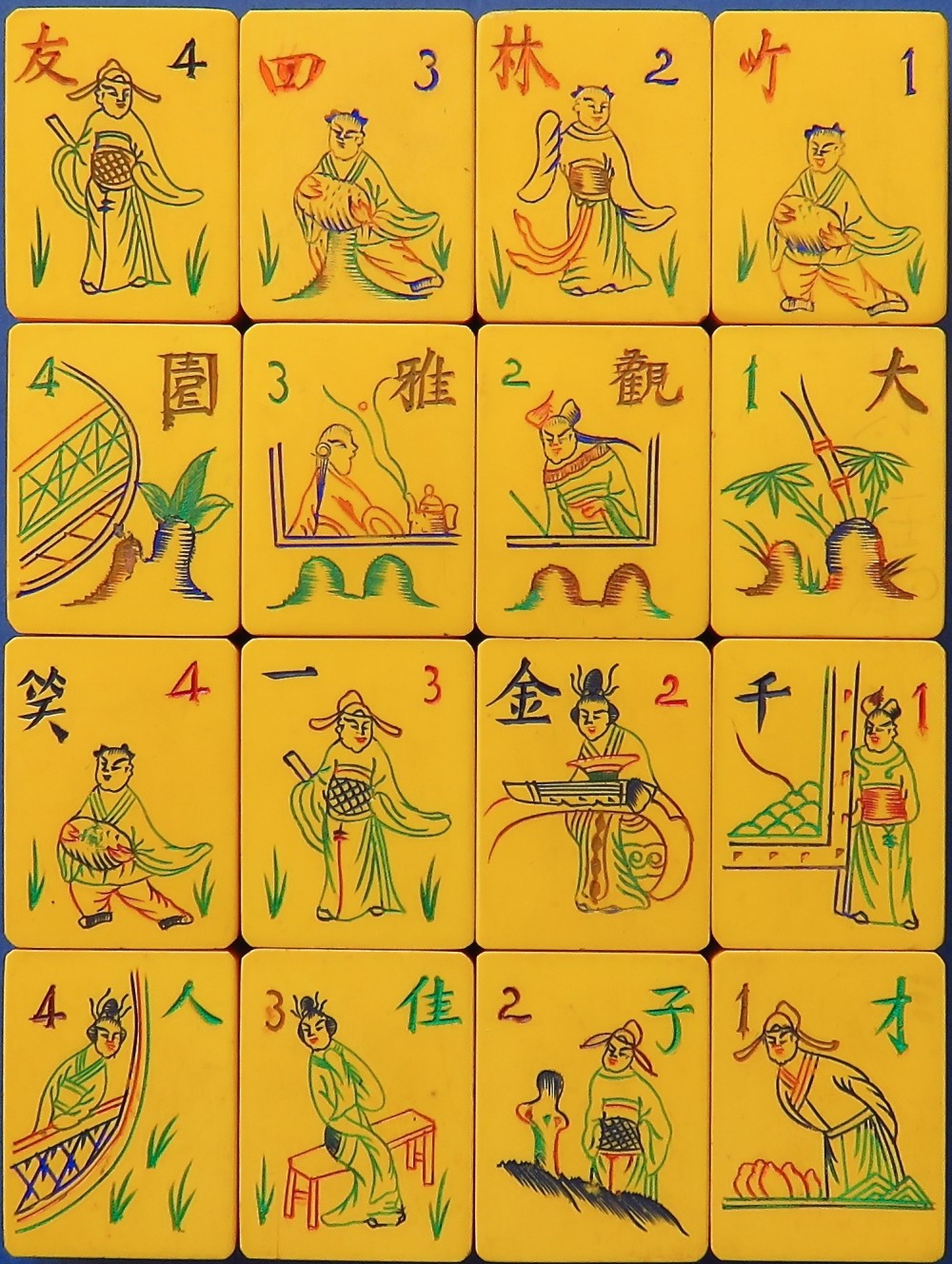
16 Flowers.
Top row;
#1, 竹, Zhu, "Bamboo"
#2, 林, Lin, "Forest"
#3, 四, Si, "Four"
#4, 友, You, "Friend"
This translates to "Four friends in the bamboo grove". However, there are many references to seven rather than four in the bamboo grove, so the number four may have been used to match the number of mahjong players.
2nd row;
#1, 大, Da, "Large"
#2, 觀, Guan, "Sight"
#3, 雅, Ya, "Elegant"
#4, 園, Yuan, "Garden"
This translates along the lines of "Grand view of a beautiful garden". Ya, is commonly used when referring to feminine beauty, and is used as 優雅, Youya, meaning "graceful".
3rd row;
#1, 千, Qian, "Thousand"
#2, 金, Jin, "Gold"
#3, 一, Yi, "One"
#4, 笑, Xiao, "Smile"
千金一笑, Qian Jin Yi Xiao, "A smile is worth a thousand pieces of gold". This refers to the idea that a smile from a beautiful girl is priceless.
Bottom row;
#1, 才, Cai, "Talent"
#2, 子, Zi, "Child" or "person". This is used in Classical Chinese to mean a respected and learned scholar.
#3, 佳, Jia, "Beautiful"
#4, 人, Ren, "Person"
Together though, Cai Zi Jia Ren are used to mean "gifted scholar, beautiful lady" which is an idiom for a pair of ideal lovers. A slightly different interpretation is "genius and beauty" and is used to mean a stereotypical couple "...the hero and heroine in a type of romance in which a talented young man and a beautiful girl meet and fall in love and, after overcoming many obstacles, marry and live happily ever after...".
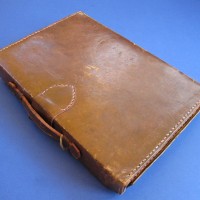
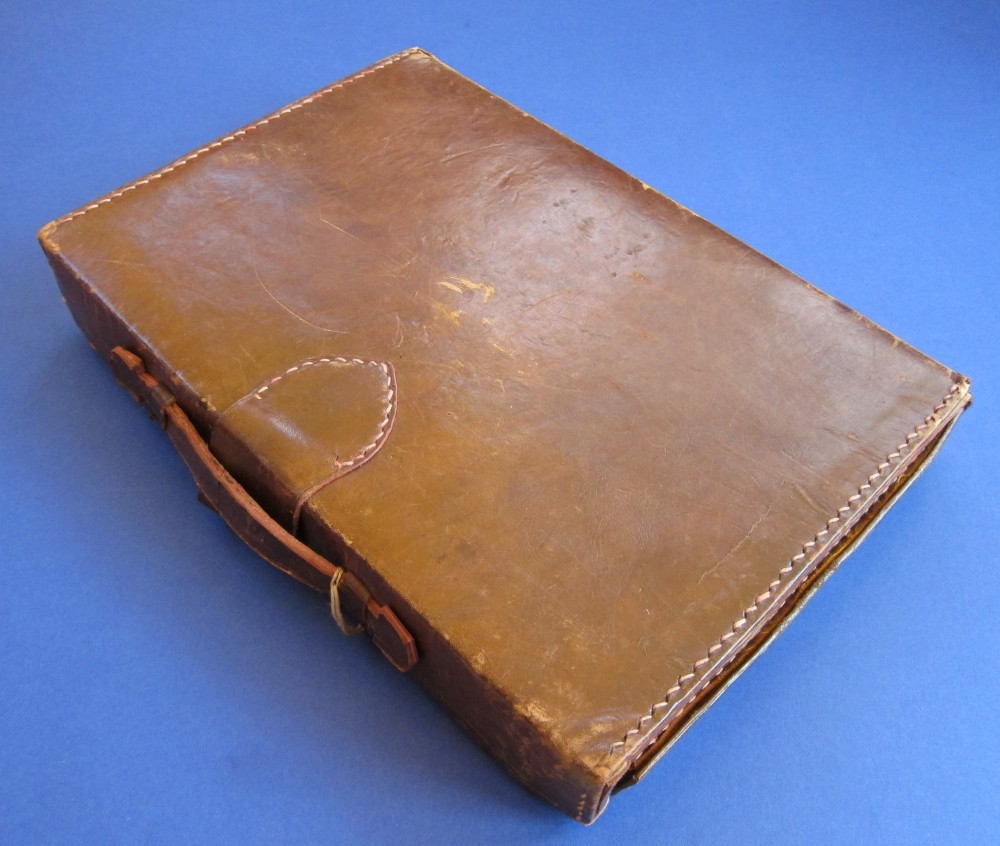
Thick leather-lined cardboard attaché-style case. Four trays for the suit tiles and a fifth for the tile set's accessories.
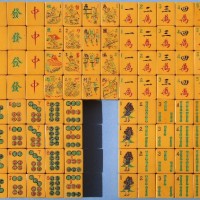
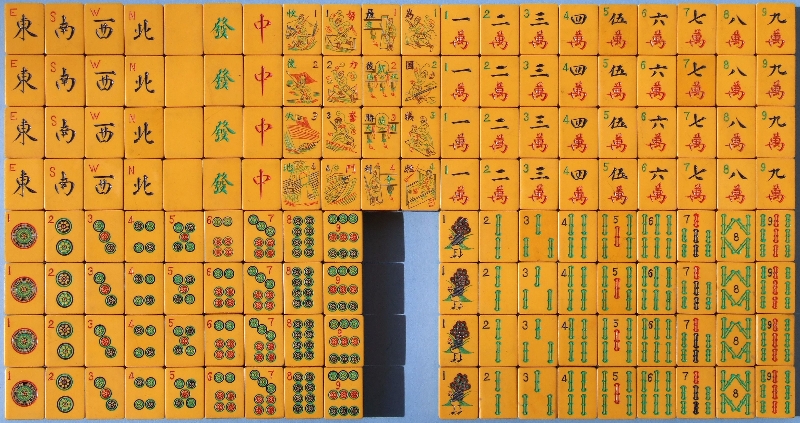
This is an important example of a type of tile set that can trace its lineage back to the earliest documented tile sets. This type also came in bone and bamboo (see the section Guest Contributions). It has all the usual features of a Culin type set with the suits ornately engraved. However, it also has sixteen Flowers/Seasons tiles. These portray scenes depicting conflict in the Sino Japanese war. This type of set is discussed in the article 'Flowers and Kings: A Hypothesis of their Function in Early Ma Que' in the section 'Tile Set History'. (Go to next picture).
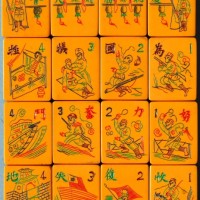
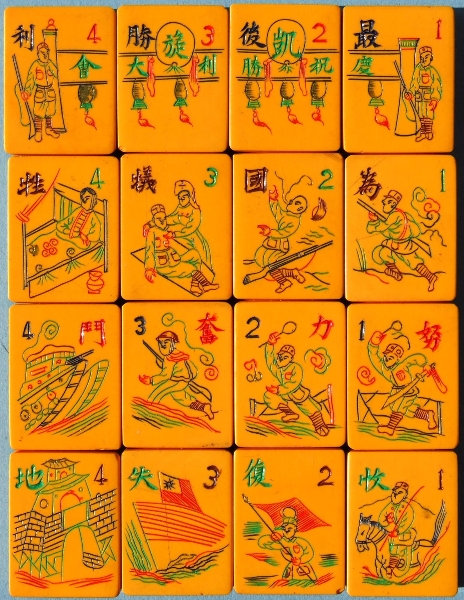
This close-up shows the level of fine engraving in more detail.
Top row;
最後勝利
Zui Hou Shen Gli
"Final Victory" (Against Japan).
In the two large ovals on tiles #2 and #3;
凱旋
Kai Xuan
"Return Triumphant"
On the long banner...;
慶祝勝利大會
Qing Zhu Shen Gli Da Hui
"An Assembly to Celebrate Victory". However, "The Victory Celebration Rally" may be a better translation.
Second row;
為國犧牲
Wei Guo Xi Sheng
"To sacrifice oneself for the country, or to lay down one's life for the country".
Third row;
努力奮鬥
Nu Li Fen Dou
"Exert oneself in the struggle".
Bottom row;
收復失地
Shou Fu Shi Di
"To recover lost territory".
[Special thanks to Ray Heaton for most of the translations.]
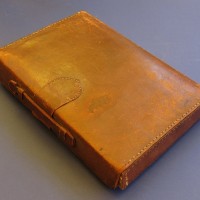
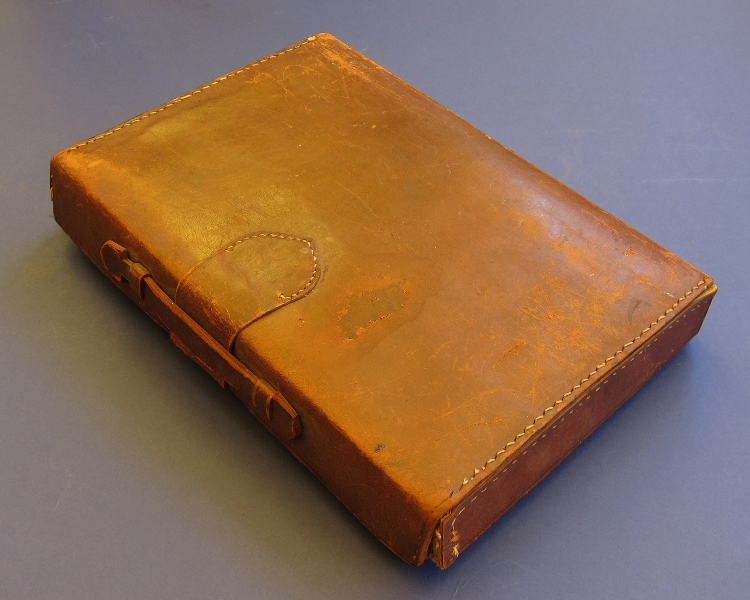
Attaché-style case of leather stitched over a cardboard frame. Five felt-lined trays for the tiles.
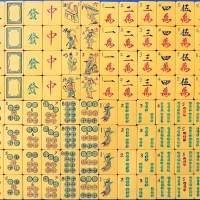
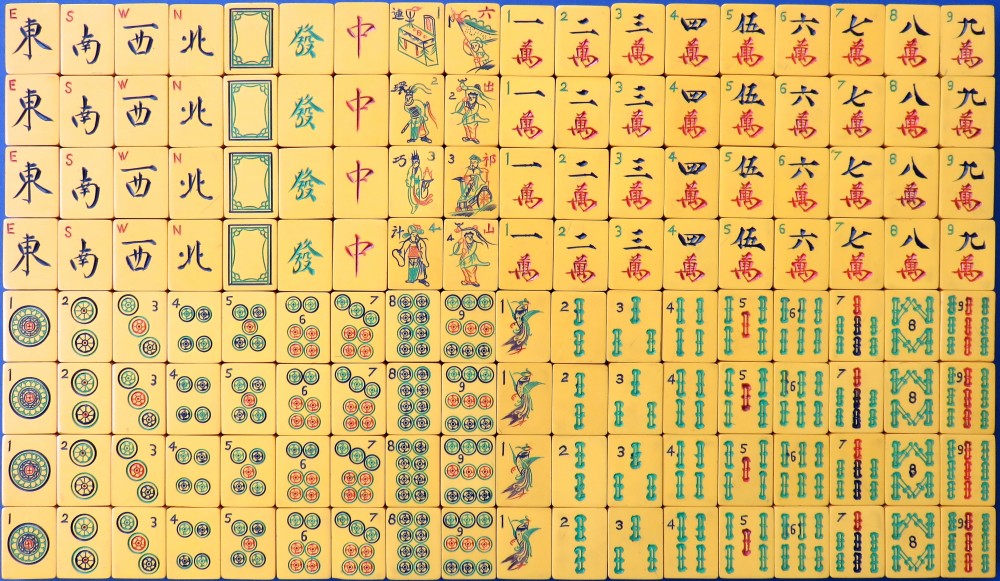
Large 'blocky' tiles. The white Honours/'Dragon' is framed. The suits are ornately engraved with a standing Phoenix on the number one SoC/'Bamboo'. The Flowers/Seasons left quartet read; lian 'to join/to link'; huan? 'ring' = lian huan 'chain'; qiao 'clever'; ji 'count, idea' = qiao ji = manoeuvre; Therefore = lian huan qiao ji = "chain manoeuvre". The left quartet reads; liu 'six'; chu 'issue, produce, arise, exceed'; qi 'numerous'; shan 'mountain'.
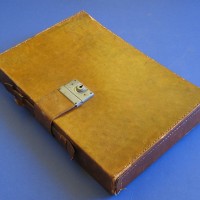
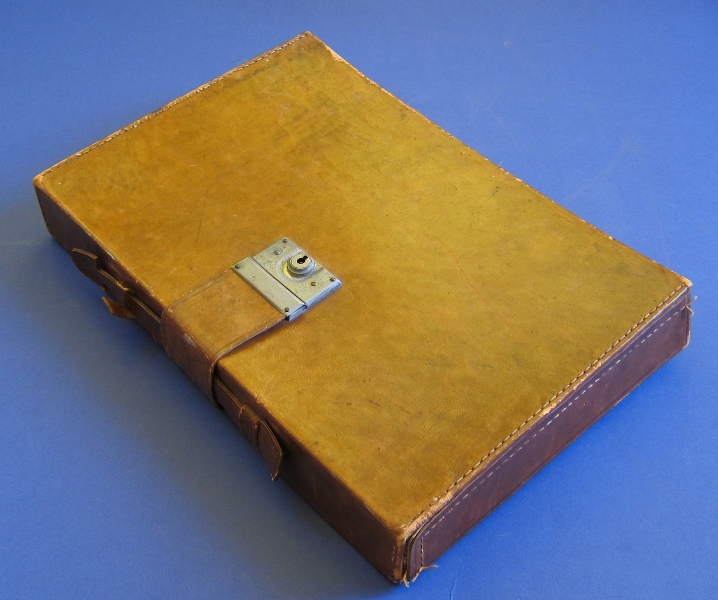
Attaché-style case - leather stitched over a cardboard frame. Felt tile and accessories trays inside.
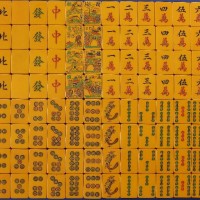
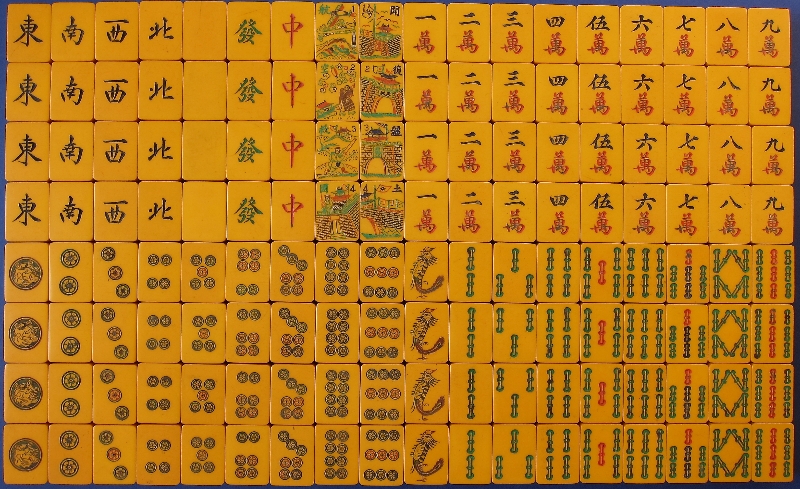
Large tiles with black backing wafer. Ornate engravings on the suits and fully engraved Flowers/Seasons. The one Cash/'Circles each have a dragon inside the large circle and the one SoC/'Bamboos' each have a standing phoenix. The Flowers/Seasons group depict scenes of war - plane and bomb - and fortresses. These illustrations were also used in sixteen Flowers/Seasons sets. The left quartet read; hang 'navigate (air)' + kong 'empty space' = hang kong = 'aviation'; jiu 'rescue'; guo 'country'; Thus hang kong jiu guo = "aviation (the air force) saves the nation". The right quartet reads; kai 'move (troops)'; fu 'recover'; jiang 'boundary' + tu 'soil, earth' = jiang tu = "territory". Thus kai fu jiang tu = "move troops to recover territory".
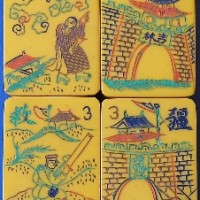
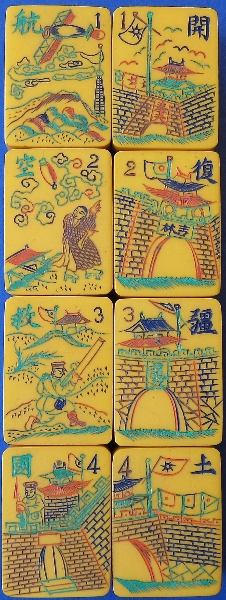
Close-up of the Flowers/Seasons displaying the fine engraving.
Close-up of the Flowers/Seasons. Note the presence of an aircraft - a rare use in these tiles - and the depictions of conflict, probably from the Sino-Japanese War/Second World War.
The 1st column of tiles reads; hang 'navigate (air)' + kong 'empty space' = hang kong = 'aviation'; jiu 'rescue' or 'to save'; guo 'country'; Thus hang kong jiu guo = "Aviation (the air force) to Save the Nation" (Coined by Sun Yat Sen. Thanks to Ray Heaton for this information).
The 2nd column of tiles reads; kai 'move (troops)', probably an abbreviation for 'kaiba'; fu 'recover'; jiang 'boundary' + tu 'soil, earth' = jiang tu = "territory". Thus kai fu jiang tu = "move troops to recover territory". On each of the gates (these are rather difficult to make out, so there may well be some errors). For tile #1, 奉天, Feng Tian. During the Manchukuo era (1932–1945) the city was called Fengtian in Chinese, and Mukden in English.
Tile #2, 吉林, Ji Lin, Jilin is in northeast China so probably a city gate in that area.
Tile #3, 奄江, Yan Jian, Yan is "to flood" and Jiang is the Changjiang River. Again, probably a city gate in that locale.
Tile #4, 河北, Hebei, an area in Northeast China.
These two columns of Flowers are repeated in the sixteen Flowers set 79.
As we have seen, the phrase "Aviation to save the Country" was used on War Bonds around 1941 to help the war effort against the Japanese. Further, Fengtian was used during the Manchukuo era (1932 - 1945) and E.A.R. Fowles left Shanghai sometime prior to late 1939 (see the caption for photo 70d). This data seems to point to the Flowers highlighting the second Sino-Japanese War from at least 1931- 1945 and a date for this set of between 1932-1939.
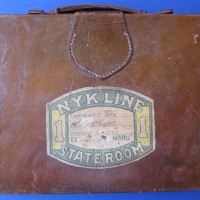
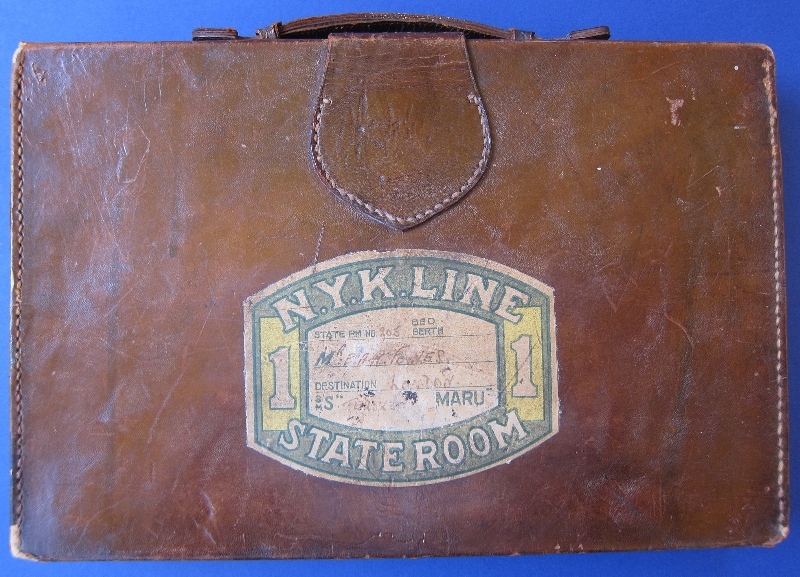
Label on the attaché-style case. It is clear that the car carries the label for the Steamship Company Nippon Yusen Kaisha (NYK) Line. The particular steamship this set travelled on was the Terukuni Maru as per the label.
The set belonged to an individual by the name of Mr E. A. R. Fowles. He was a rate-paying resident of Shanghai, according to the Shanghai Municipal Council, Report for 1937 and Budget for 1938. His entry in the Municipal Report states he had 2 votes, presumably the other for his wife.
The Terukuni Maru was sunk off the English coast on November 21st 1939 after a voyage to London, departing Yokohama on 21st September 1939 and calling at the ports of Nagoya, Osaka, Kobe, Moji and then Shanghai and Hong Kong etc. etc.
E. A. R. Fowles must have therefore set sale for London sometime during the years 1938 or 1939, taking a 1st Class State Room cabin. (Special thanks to Gregg Swain for alerting me to this information)
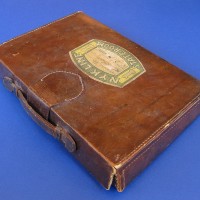
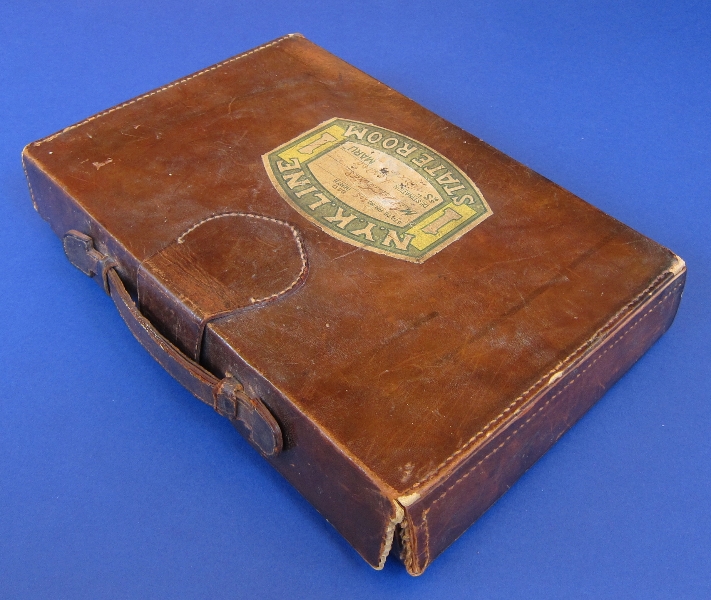
Leather stitched over a cardboard frame. Four green felt lined trays for the suits and one narrow tray for the accessories. Note that the split sides due to the stitching unravelling is quite common with these cases.
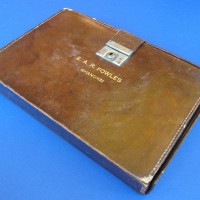
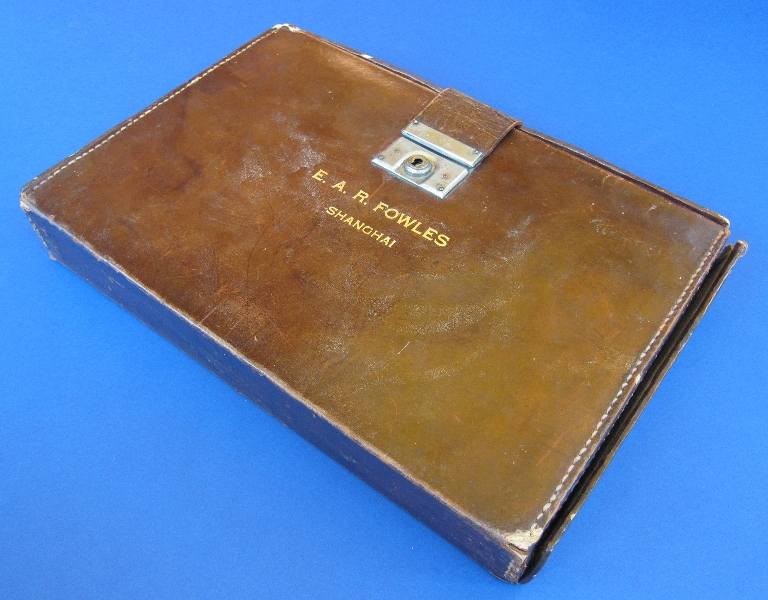
Since we have no evidence for a Hong Kong connection for E.A.R. Fowles in Hong Kong, the evidence for them being in Shanghai would indicate that this set was purchased by them in Shanghai sometime prior to late 1939. Their name also appears on the shipping label in the picture above.
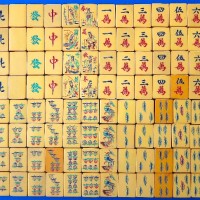
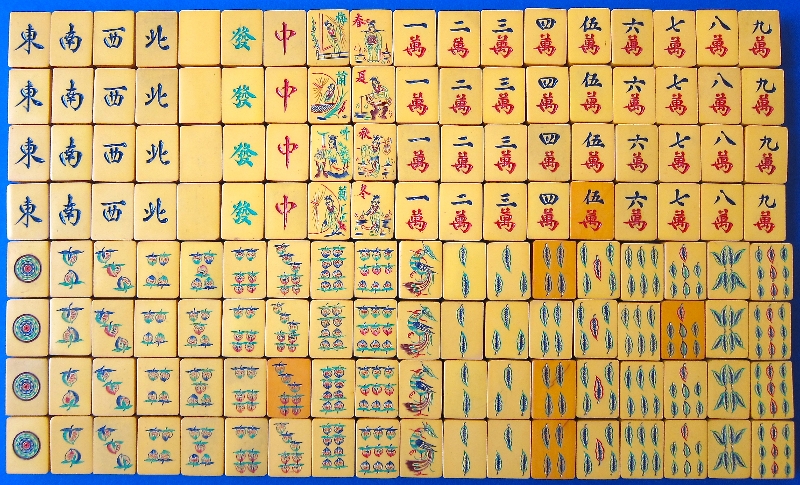
A set with small tiles backed with a black wafer. The three suits are ornately engraved with the Cash/'Circles' suit tiles 2 - 9 engraved with peaches symbolising longevity. The SoC/'bamboo' suit number one tile is decorated with a standing Phoenix with a large leaf in its beak. As mentioned in the caption to the tile set 1950-14a in the Bone and Bamboo section; "This could be the leaf of the wutong tree, said to be "the only tree on which the Phoenix would alight". (CAS Williams, 'Outlines of Chinese Symbolism and Art Motifs"). The Flowers/Seasons left quartet read; li 'plum'; lan 'orchid'; zhu 'bamboo' and ju 'chrysanthemum'. The tiles also show human figures with the respective flowers on each tile. The right quartet reads; chun 'Spring'; xia 'Summer'; qi and dong 'Winter'. These tiles also show human figures in various poses. 'Autumn'
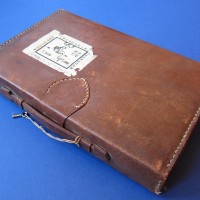
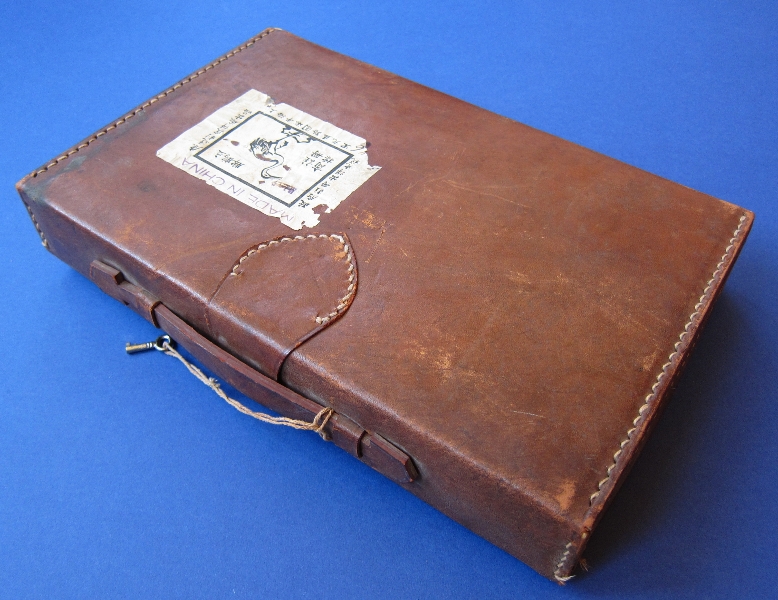
Small attaché-style case of leather stitched over a cardboard frame. Four green felt trays for the tiles and one narrow tray for the accessories. Makers label attached to the case plus key.
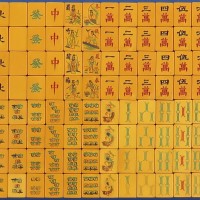
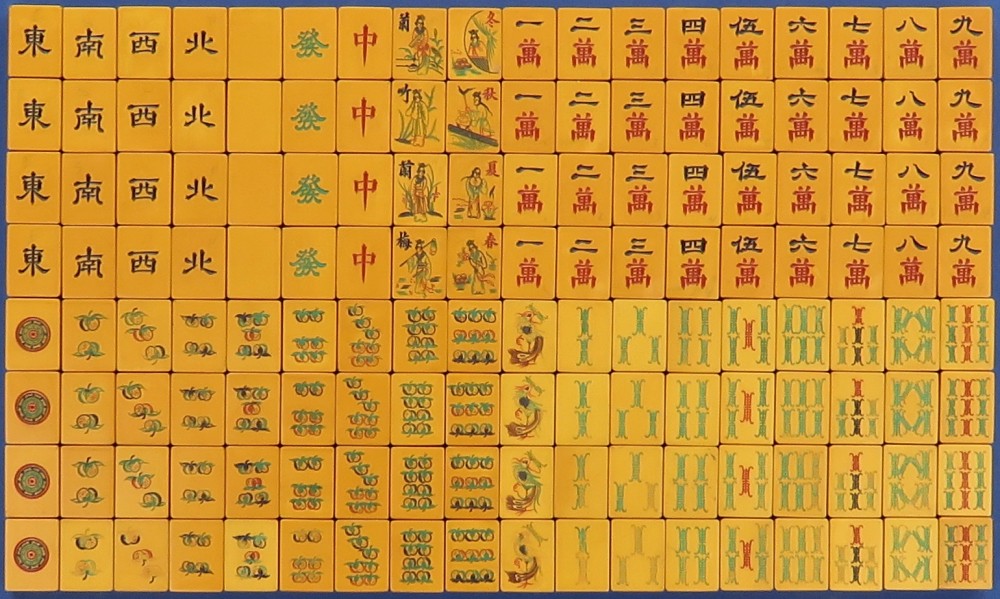
Another small small tiled set. This may be from the same manufacturer and the previous one.
It appears that one tray of tiles was not exposed to the elements such that the tiles that were in that tray have remained lighter than the others. This feature is also found in the previous set.
Notice the symbols for longevity - peaches on the "Cash/Circles/Dots" group and another rendition of the 'shou' character for longevity on the "Strings/Bamboo" suit. The Directions and 'Dragons and "Myriads/ Characters" suit show a square type of engraving style.
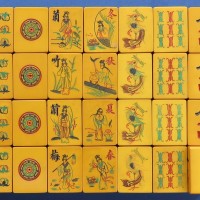
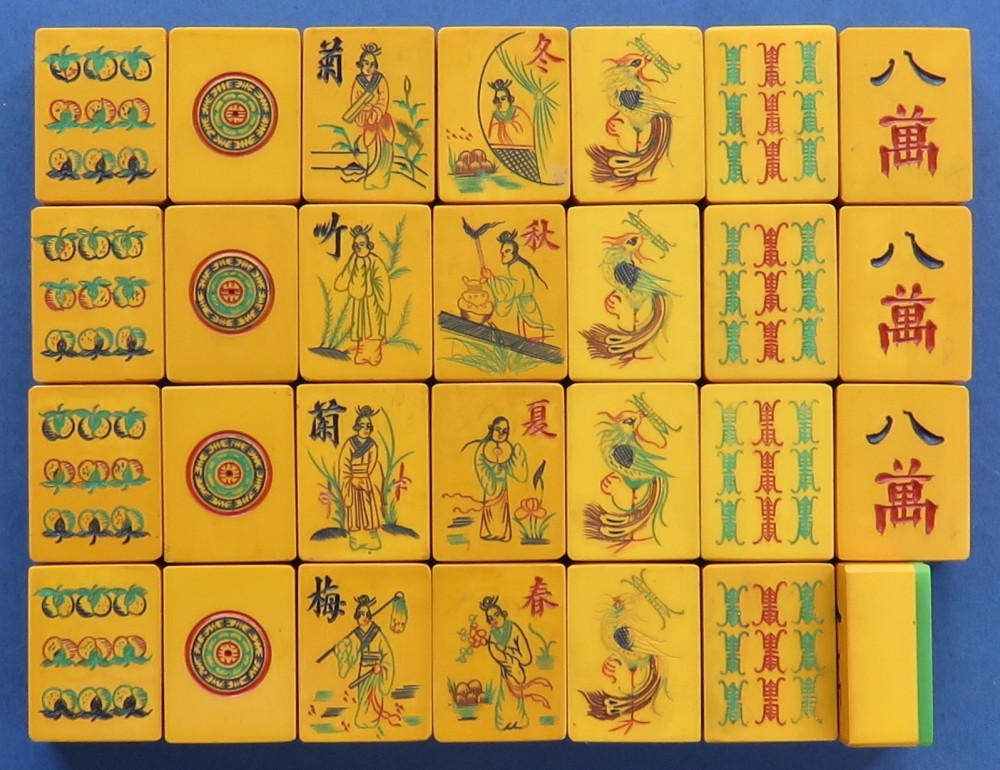
Close-up of decorative tiles. Note the 'whisker' symbol for shòu, longevity, on the 'Bamboo' tiles as well as in the bird's mouth. The bird is probably the female Phoenix 凰 huáng, with the twin-lobed tail. These two symbols are most likely saying "may you have prosperity and a long life (longevity)".
The #1 'Circle' tile has a central symbol for shòu, longevity, and this is repeated in the symbols around the outer edge of the medallion on this tile. The longevity wish is also repeated through the visual pun of the peaches, also symbols for a long life.
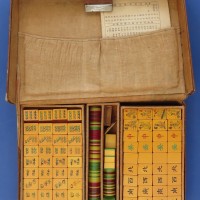
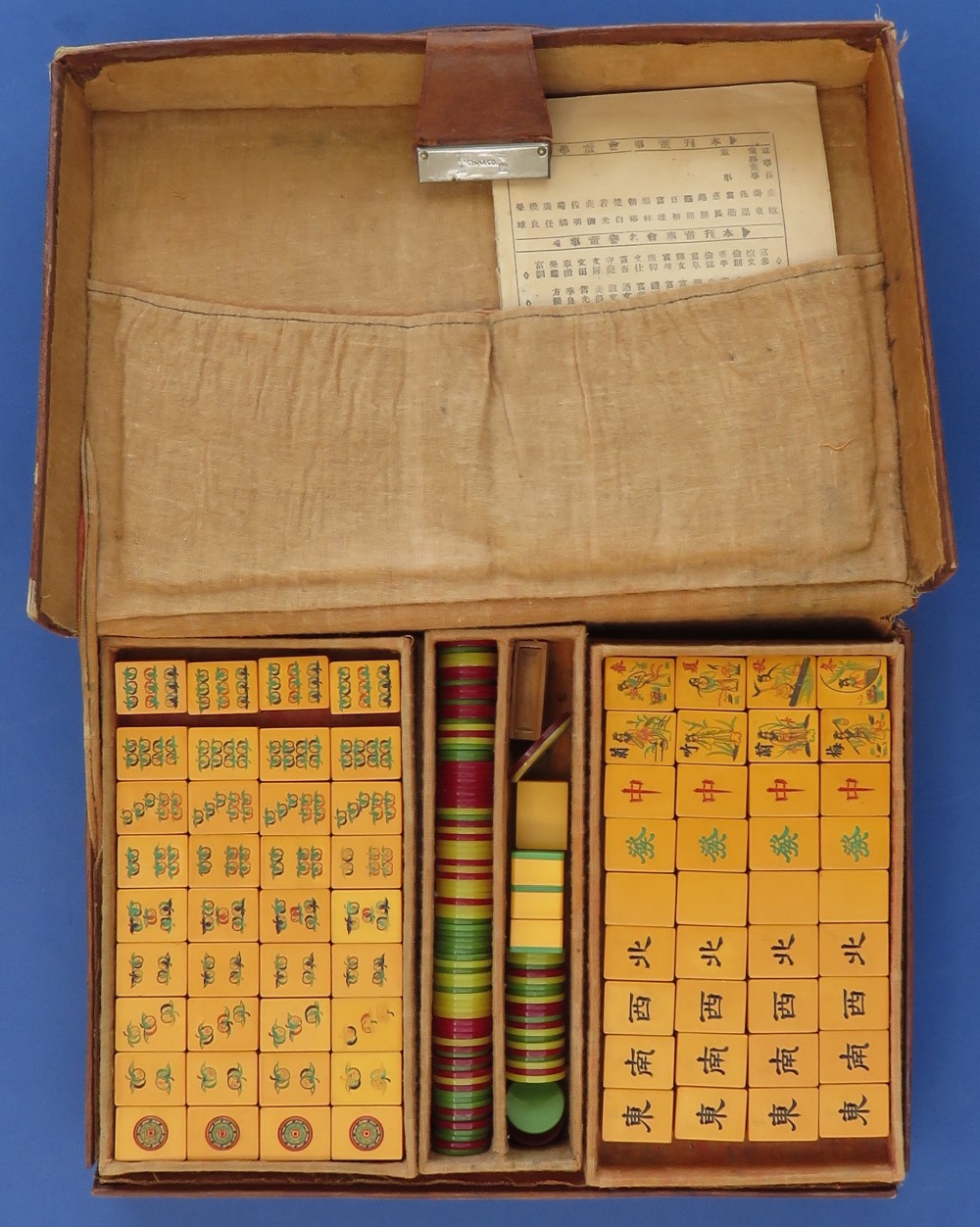
Interior of case, showing the catalin counters plus the wooden container with four bone dice plus the round catalin Wind sector disc.
The booklet is in Chinese and has advertising stamps on the inner page for retailers in Hong Kong.
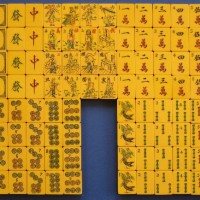
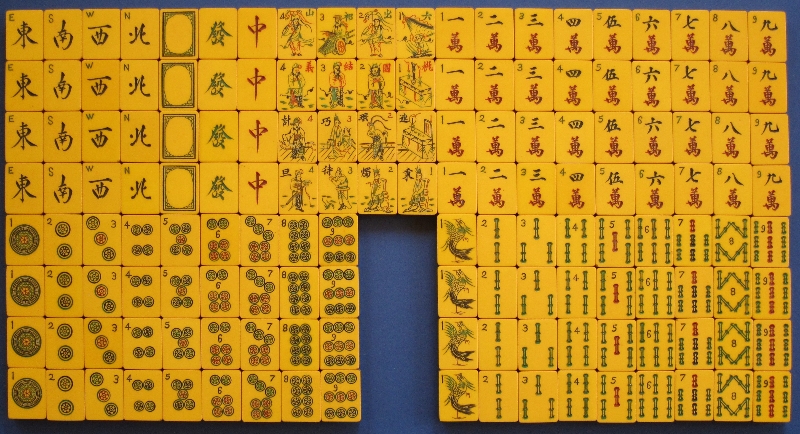
16 Flowers synthetic set.
The 1 Bamboo bird appears to be a 'Ribbon-tailed Bird', shoudainaio = shou, 壽, + dai, 帶, + niao, 鳥. The bird is often called ‘longevity-tailed bird’ shoudainiao because shou (ribbon) is a pun for shou (longevity). So it may indicate a blazing for 'longevity'.
However, the bird is on a 1 bamboo tile, bamboo being zhu, 竹. Bamboo is also a pun for 'congratulate', zhu, 祝. According to Bartholomew's 'Hidden Meanings in Chinese Art', the Ribbon-tasiled Bird + Bamboo can mean "Birthday Greetings". However, this may also just be a 'Wish for Longevity".
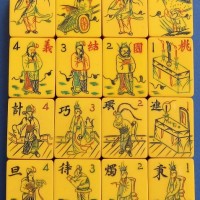
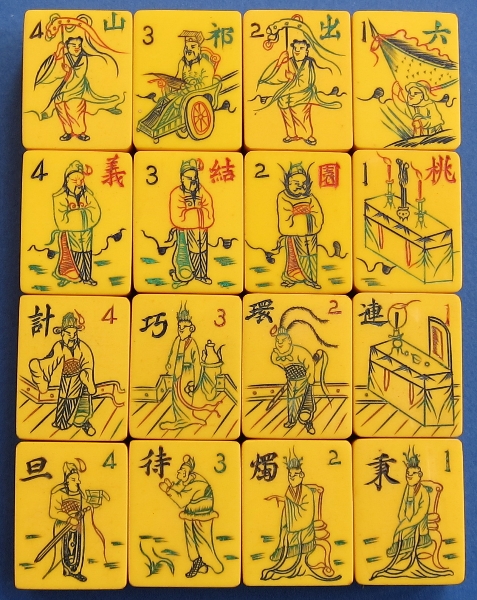
These are The Romance of The Three Kingdoms tiles.
Top row:
#1, 連, Lian, "Link"
#2, 環, Huan, "Ring"
#3, 巧, Qiao, "Skilful"
#4, 計, Ji, "Plan"
This gives us 連環巧計, Lianhuan Qiaoji, meaning "the chain links strategy". It refers to Pang Tong's military plan to link Cao Cao's battleships together with strong iron chains, so as to make the ships more stable when they were sailing, as well as to reduce the chances of Cao's soldiers falling seasick due to excessive rocking. This plan, however, contributed to Cao Cao's defeat as his battleships were unable to separate from each other during the fire attack in the battle, and when one ship is set aflame, the other ships linked to it caught fire as well.
2nd row:
#1, 六, Liu, "Six"
#2, 出, Chu, "Issue" or "Produce"
#3, 祁, Qi, "Large" or "Numerous"
#4, 山, Shan, "Mountain"
Although the words "Issue" and Produce" are used to translate tile #2, 出 can also translate (less commonly) to "Campaign" - as in Military Campaign. The full translation of these four should therefore be "Six Campaigns from Qishan"; this is where Zhuge Liang, military strategist launches six military campaigns against a rival state (one of the Three Kingdoms in the novel). It was based on actual historical events but with some artistic licence applied to increase the actual number of campaigns to six! Qishan can be further translated as Mount Qi, although it is sometimes left as Qishan. Zhuge Liang is the human figure on tile #3.
http://en.wikipedia.org/wiki/Zhuge_Liang's_Northern_Expeditions
http://the-scholars.com/viewtopic.php?f=5&t=9954
3rd row:
#1, 秉, Bing, "To Hold" or "To Grasp"
#2, 燭, Zhu, "Candle"
#3, 待, Dai, "Await"
#4, 旦, Dan, "Daybreak"
The approximate translation is "to wait for daybreak holding a candle".
This is perhaps where Cao Cao (the main villain of the story) tries to temp Guan Yu, one of the three sworn brothers....
An extract from the relevant section of the book...
"For the journey to the capital, a carriage was prepared for the two ladies, and Guan Yu was its guard. On the road they rested at a certain post station, and Cao Cao, anxious to compromise Guan Yu by beguiling him into forgetfulness of his duty, assigned Guan Yu to the same apartment as his sisters-in-law. Guan Yu stood the whole night before the door with a lighted candle in his hand. Not once did he yield to fatigue. Cao Cao's respect for him could not but increase."
4th (bottom) row:
These tiles are the "swearing brotherhood in the peach garden"; 桃園結義, Tao Yuan Jie Yi, and refer to the making of a pact of brotherhood.
#1, 桃, Tao, "Peach"
#2, 園, Yuan, "Garden"
#3, 結, Jie, "Bond"
#4, 義, Yi, "Justice"...but these last two together are "to swear brotherhood"
Here is an extract...
"When saying the names Liu Bei, Guan Yu and Zhang Fei, although the surnames are different, yet we have come together as brothers. From this day forward, we shall join forces for a common purpose, and come to each other's aid in times of crisis. We shall avenge the nation from above, and pacify the citizenry from below. We seek not to be born on the same day, in the same month and in the same year. We merely hope to die on the same day, in the same month and in the same year. May the gods of heaven and earth attest to what is in our hearts. If we should ever do anything to betray our friendship, may the gods in heaven strike us dead."
Tiles #2, #3 and #4 show the three sworn brothers, and tile #1 represents the alter at which they swore brotherhood. [translation by Ray Heaton].
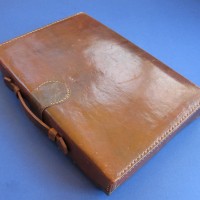
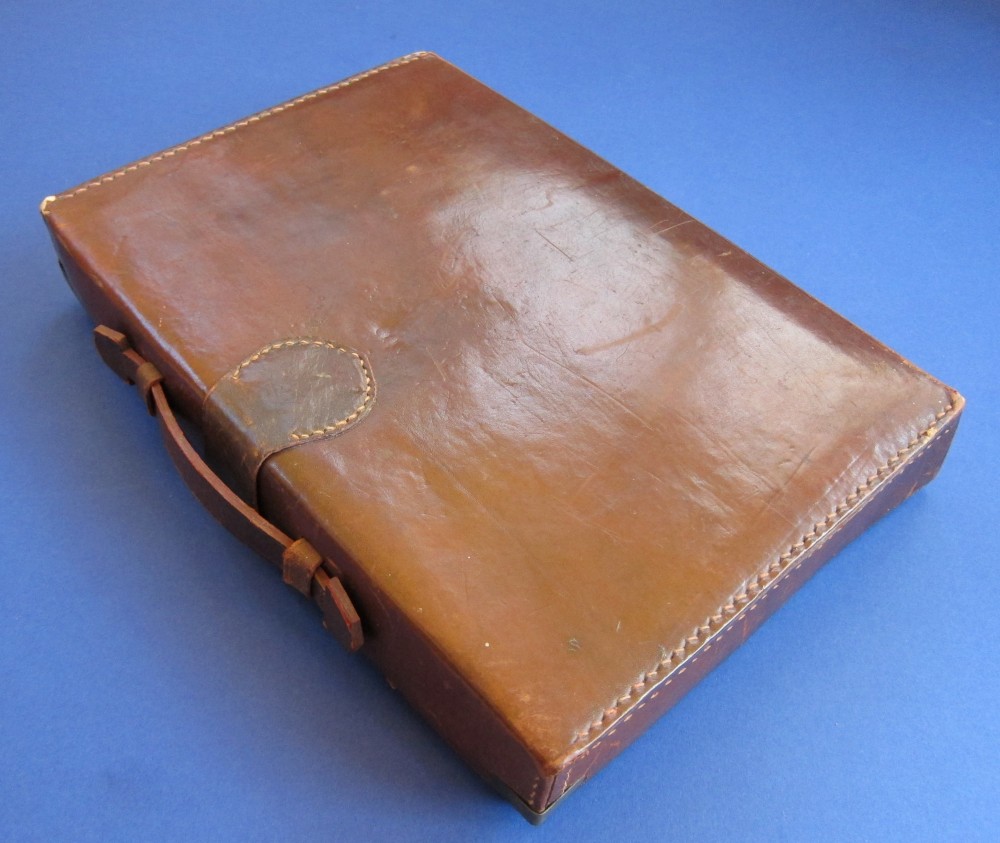
Leather over cardboard attaché-style case. Four felt-lines trays for the tiles plus a fifth, thin, felt-lined tray for the set's accessories - four spare blanks + bone scoring sticks, four dice and a bone ming containing the bone Directions discs.
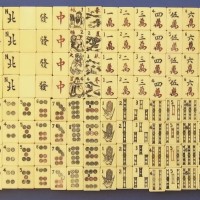
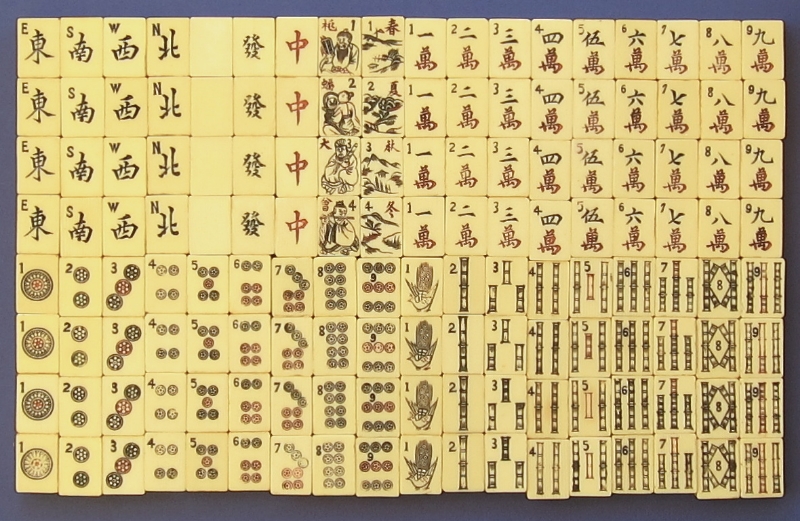
This is an example of an engraved 'French Ivory' tile set. As with other sets it has ornate engravings for the three suits and fully carved Flowers/Seasons.
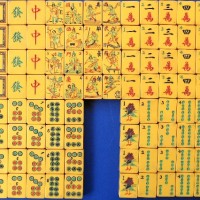
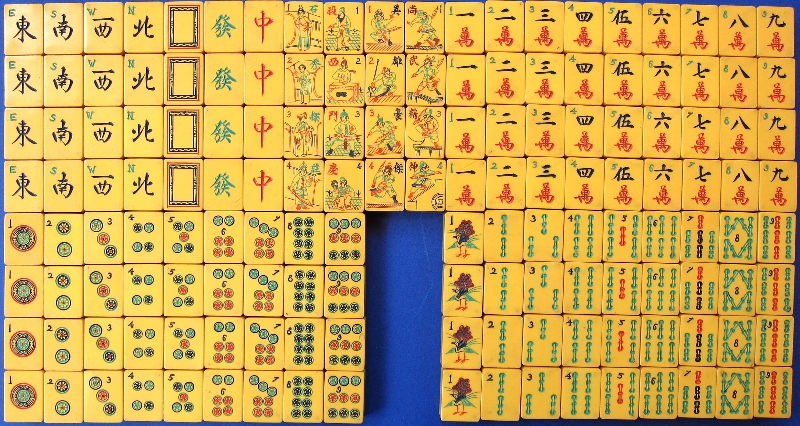
Another sixteen Flowers/Seasons tile set. Like many of this calibre, the engravings on the tiles form, when arranged correctly, a continuous scene (see the next picture). The scenes are taken from the Water Margin., one of the four important books of Chinese Literature. The characters from the novel were used for the 'wan', ten thousand' suit in the three-suited money cards that gave rise to MJ.
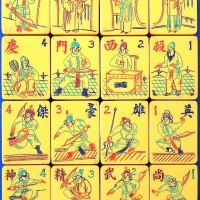
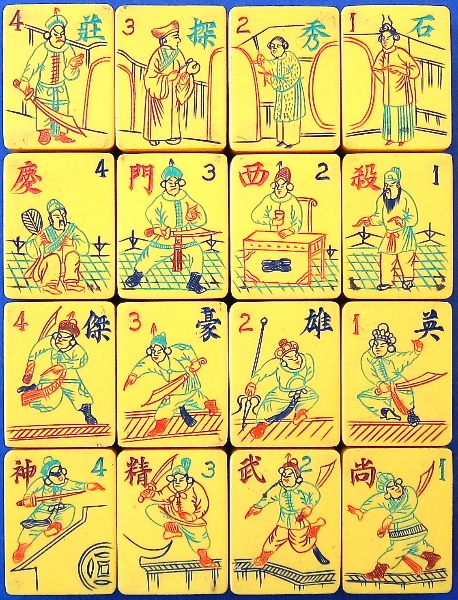
Close-up of the tiles placed in correct orientation and showing for each row a continuous scene from the novel the 'Water Margin'. The top row reads; "Shi Xiu tan zhuang" = "Shi Xiu scouts out the farmstead (or village)", or "Shi Xiu spies on the village" and is where Shi Xiu infiltrates the Zhu Family's village. The 2nd row reads; "Sha Xi men qing" = "the killing of Ximen Qing". This refers to the episode in the Water Margin story where Wu Song takes revenge for his brother's death by killing his brother's adulterous wife and her lover Ximen Qing. The 3rd row reads; "Ying xiong Hao Jie". This is really two ways of referring to "Hero", and probably refers to the 108 heroes of the novel. The 4th row reads; "Shang Wu Jing Shen" = something along the lines of "Martial Spirit", and is a way of celebrating the martial art skills of the heroes in the story. [Translation courtesy of Ray Heaton].
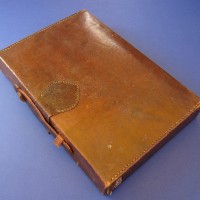
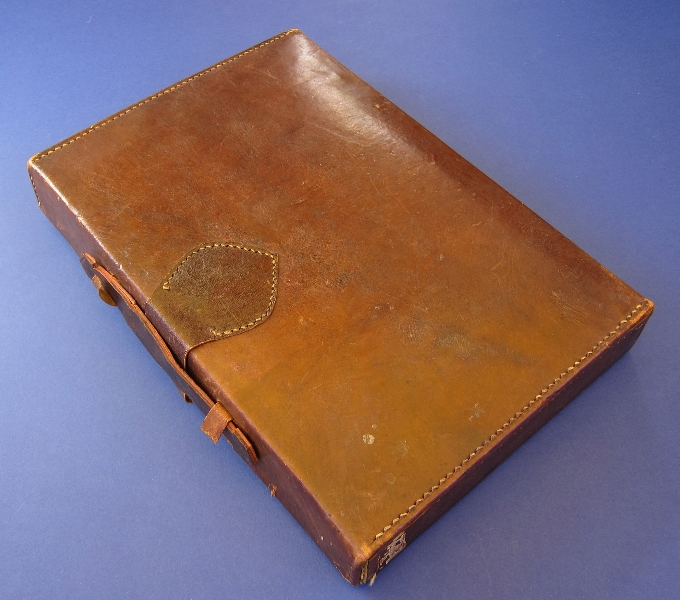
Attaché-style case of leather stitched over a thick cardboard frame. Five felt-lined trays inside.
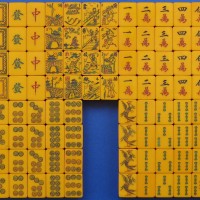
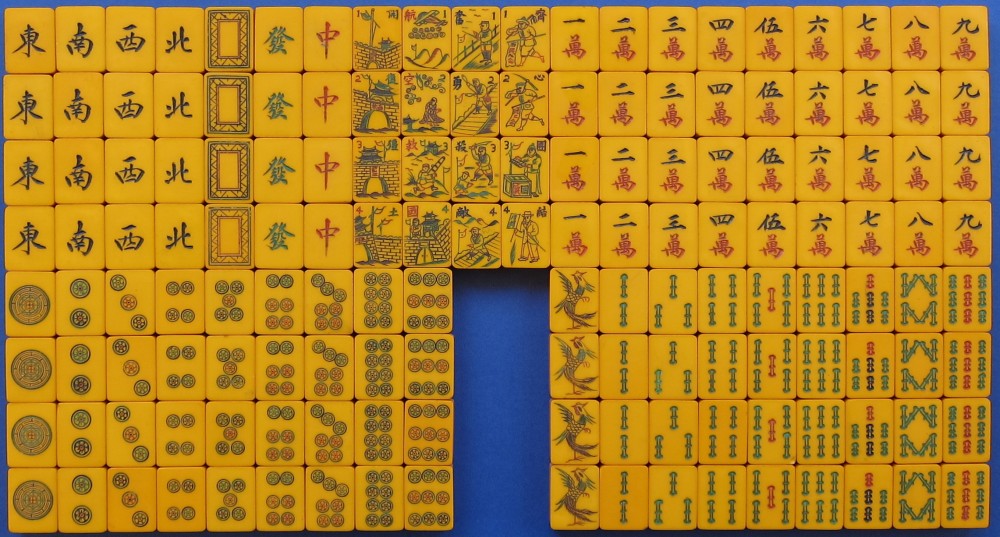
This set contains large tiles without a backing wafer unlike its smaller counterpart, set 1930-32a. Thus, the differences, this set displays from 1930-32a - are sixteen Flowers/Seasons tiles and four White 'Dragon' tiles with a frame. The similarities are the standing Phoenix on the number one String of Cash/'Bamboo' and eight of the Flowers/Seasons which are nearly identical.
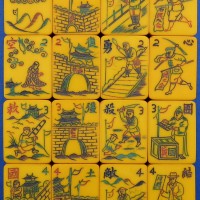
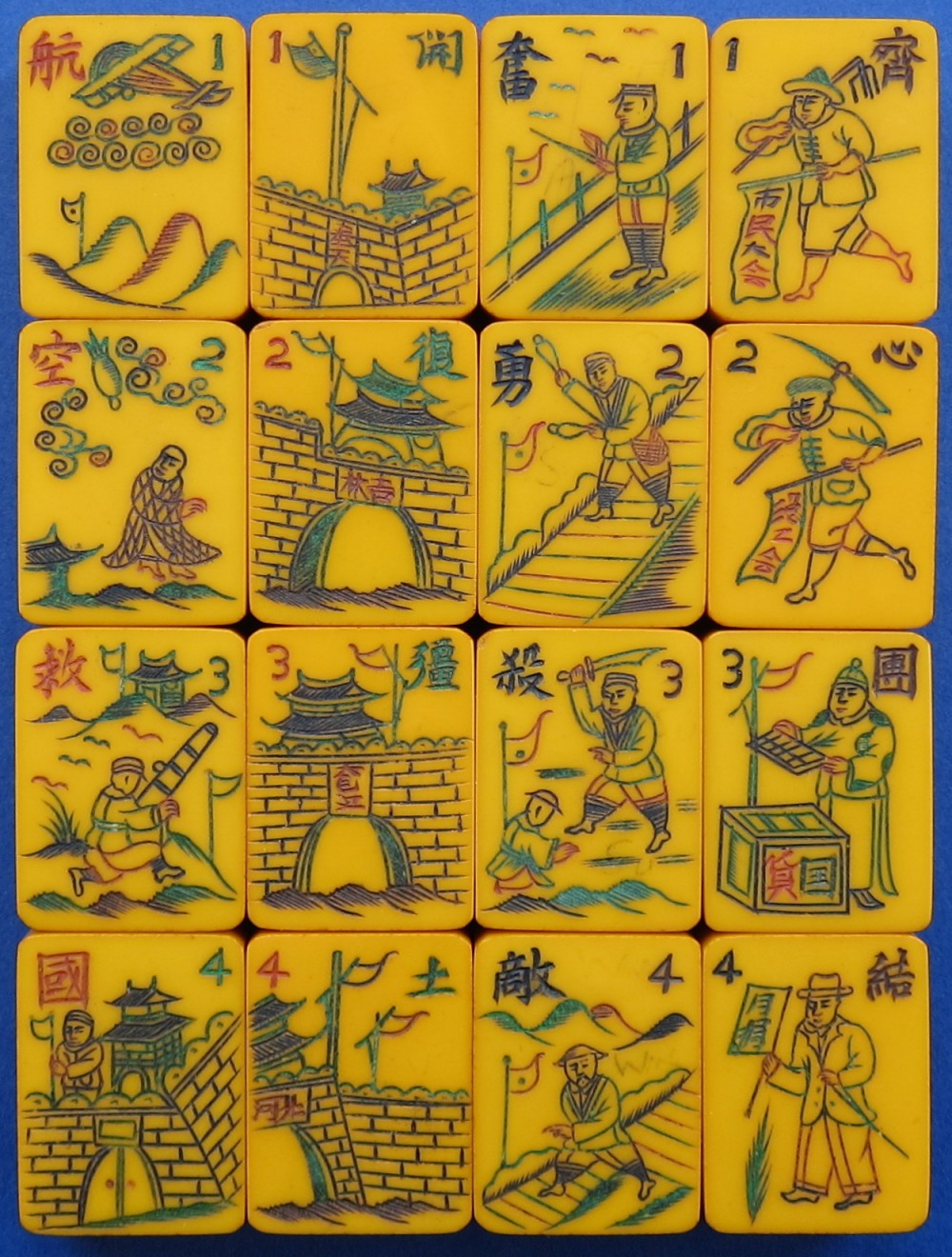
Close-up of the Flowers/Seasons. Note the presence of an aircraft - a rare use in these tiles - and the depictions of conflict, probably from the Sino-Japanese War/Second World War.
The 1st column of tiles reads; hang 'navigate (air)' + kong 'empty space' = hang kong = 'aviation'; jiu 'rescue'; guo 'country'; Thus hang kong jiu guo = "aviation (the air force) saves the nation".
The 2nd column of tiles reads; kai 'move (troops)', probably an abbreviation for 'kaiba'; fu 'recover'; jiang 'boundary' + tu 'soil, earth' = jiang tu = "territory". Thus kai fu jiang tu = "move troops to recover territory". On each of the gates (these are rather difficult to make out, so there may well be some errors here!). For tile #1, 泰天, Tai Tian, presumably a city wall or gate with such a name. Tile #2, 吉林, Ji Lin, Jilin is in northeast China so probably a city gate in that area. Tile #3, 奄江, Yan Jian, Yan is "to flood" and Jiang is the Changjiang River. Again, probably a city gate in that locale. Tile #4, 河北, Hebei, an area in Northeast China.
The 3rd column of tiles reads; 奮勇殺敵, (fen yong sha di) "Summon up all your courage and energy to fight the enemy".
The 4th column of tiles reads; 齊心團結,(Qi Xin Tuan Jie). "To be of one mind and unite [to fight the enemy]". The extras on this column of tiles are; Tile #1 flag; 帀民大会, (Za Min Da Hui) probably akin to "to form the people in to a mass rally". Tile #2 flag, 浸工會, (Jin Gong Hui) "to belong in the labour union". Tile #3 box; 國貨, (Guo Huo) "Goods made in China". Tile #4 flag; 月捐(Yue Juan), this may mean "monthly taxes", (the human figure might be a tax collector?). [Most translations by Ray Heaton, with thanks.]
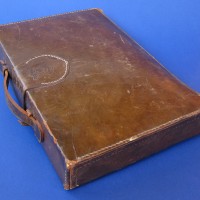
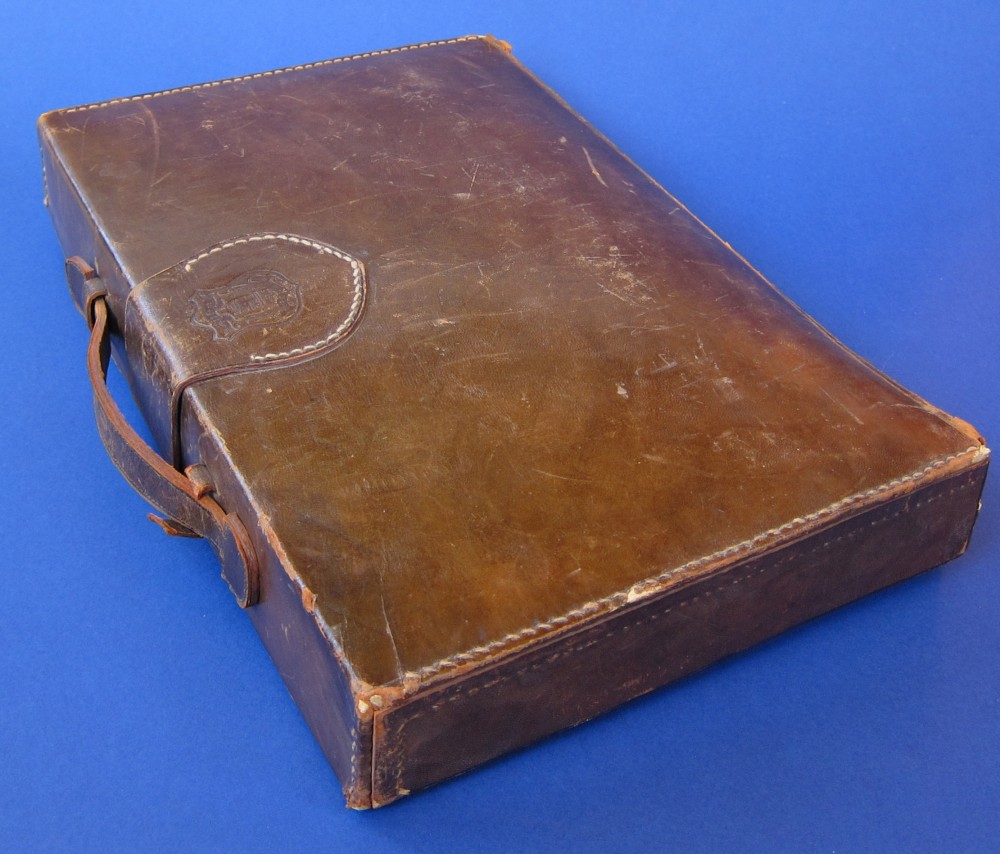
Attaché-style case containing four green felt-lined trays for the tiles and one narrow one for the bone scoring sticks, dice and Directions indicator.
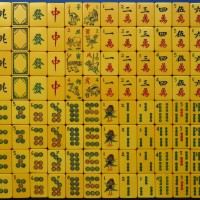
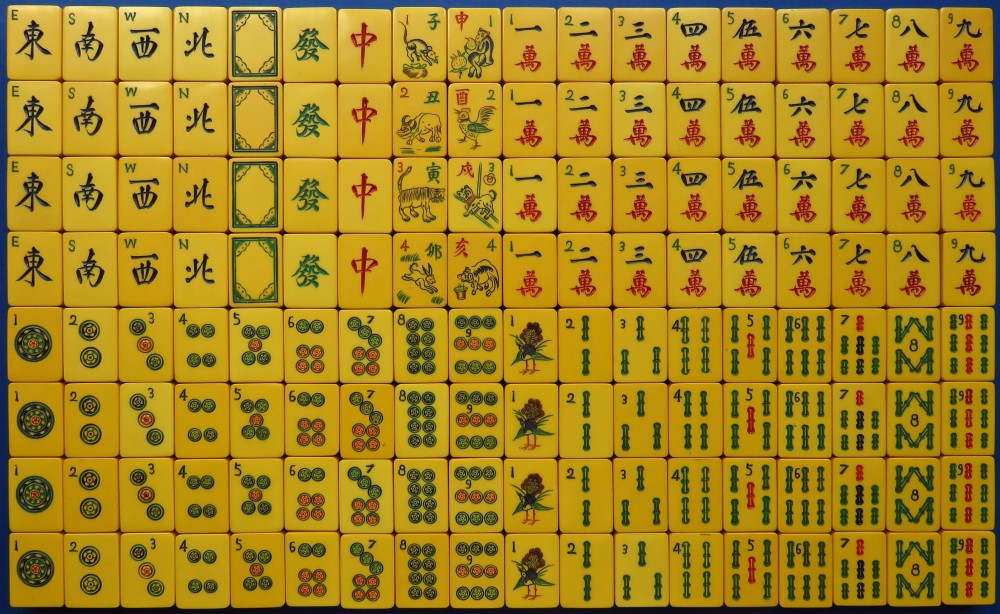
A pristine Chinese Bakelite set. Beautifully carved and coloured number one tiles.
Framed White 'Dragon' tiles.
Animals feature on the Flowers tiles.
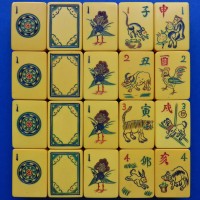
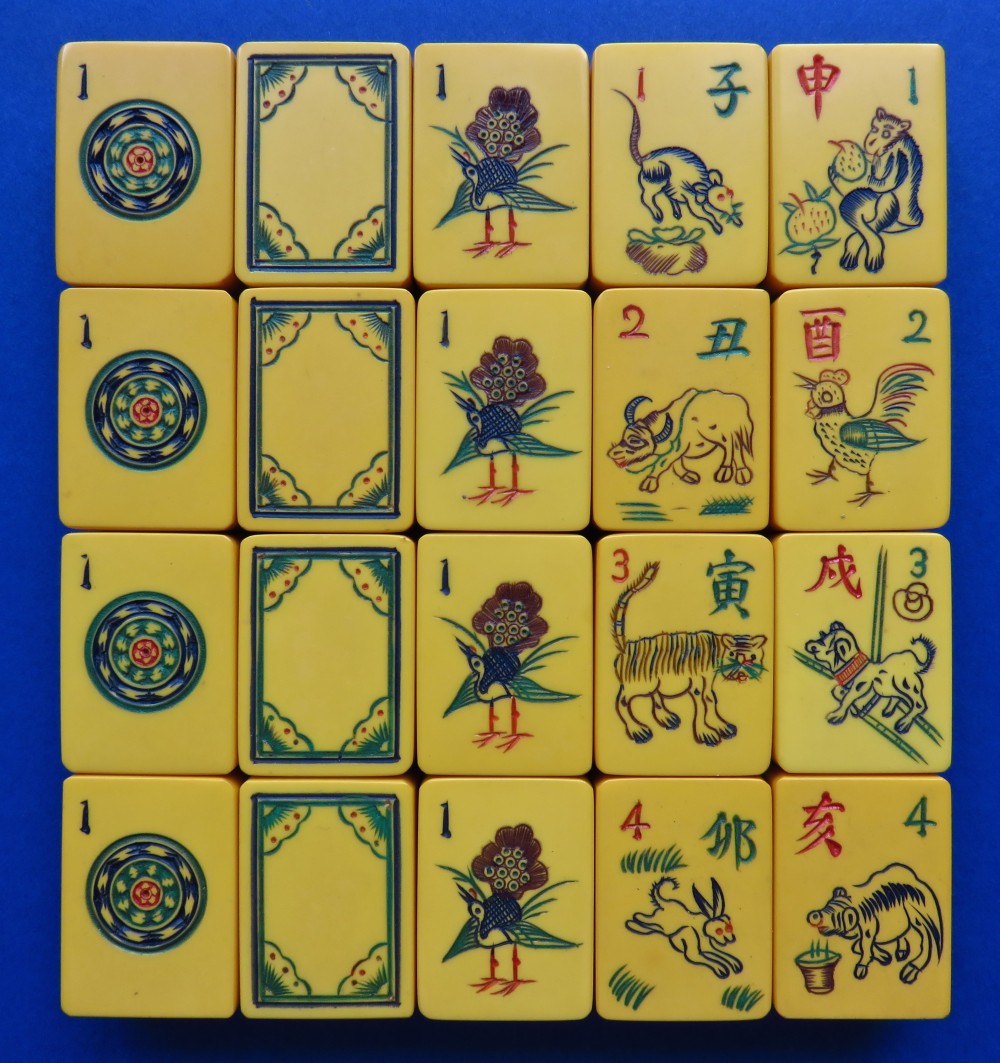
Close-up of the number 1 'Circles', the framed White 'Dragons', the number 1 'Bamboos' and the two quartets of 'Flowers'.
The 'Flowers' are unusual. They represent 8 of the 12 Earthly Branches that are part of a group of 60 time combinations that form the Sexegenary Cycle of the Chinese Calendar.
Each tile of the two quartets has a sinogram/character plus an animal engraved on it and each pair of motifs on each tile are complementary. Thus, for the left hand quartet, from 1 - 4;
zǐ = 1st Earthly Branch and its Chinese Zodiac symbol the Rat.
chǒu = 2nd Earthly Branch and its Chinese Zodiac symbol the Ox.
yín = 3rd Earthly Branch and its Chinese Zodiac symbol the Tiger.
mǎo = 4th Earthly Branch and its Chinese Zodiac symbol the Rabbit.
The right hand quartet, from 1 - 4;
shēn = 9th Earthly Branch and its Chinese Zodiac symbol the Monkey.
yǒu = 10th Earthly Branch and its Chinese Zodiac symbol the Rooster.
zū = 11th Earthly Branch and its Chinese Zodiac symbol the Dog.
hài = 12th Earthly Branch and its Chinese Zodiac symbol the Pig.
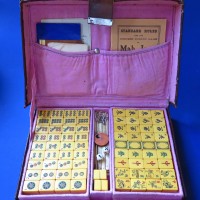
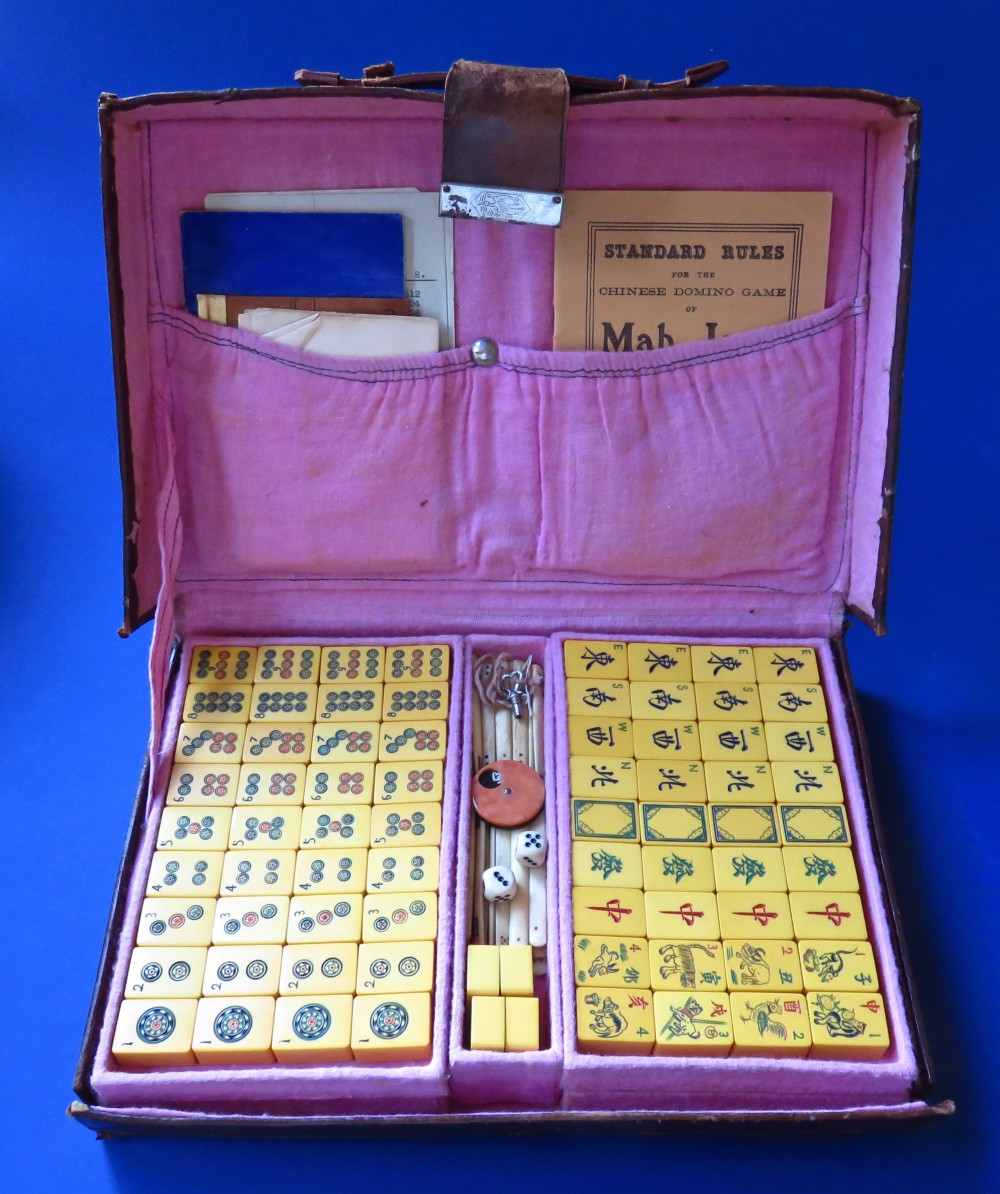
Inside of the attaché-style case showing the arrangement of the trays of tiles and the accessories tray.
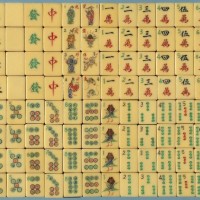
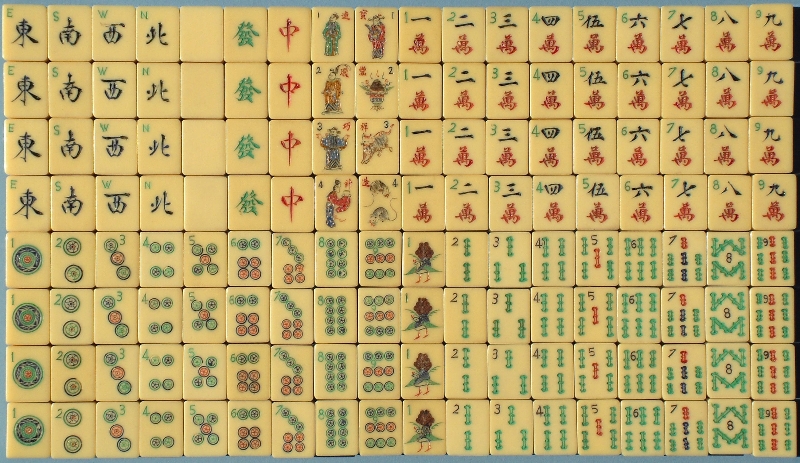
Small, light yellow tiles with dark red wafer bases. The Flowers/Seasons are very well engraved and decorated with the three suits patterns ornately decorated. For the Flowers/Seasons see the next picture.
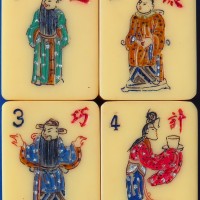
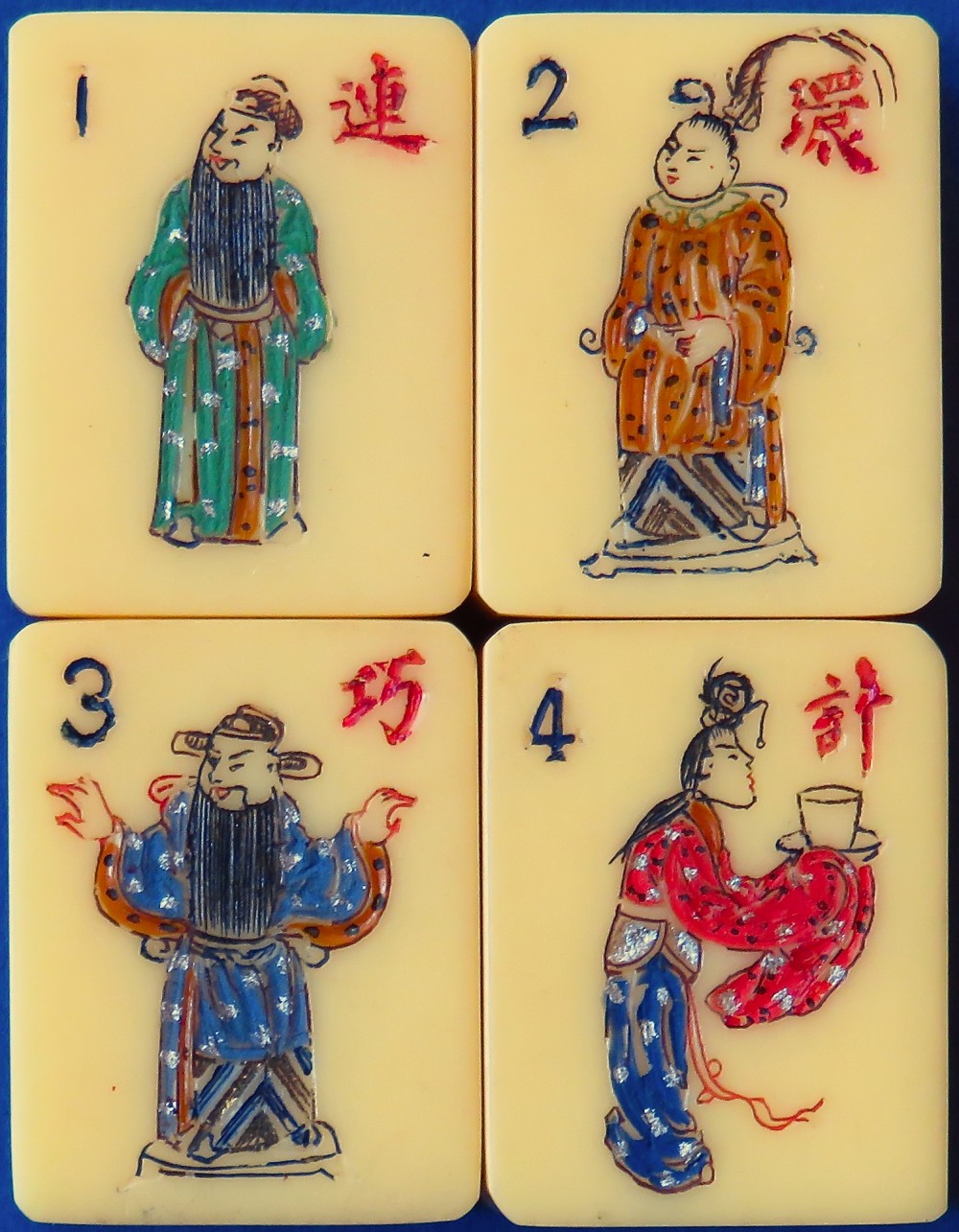
This quartet reads (in numerical order); qi? 'in good order'; ? ; xiang 'auspicious'; zao 'made'; This may be a description of the tile set by the maker.
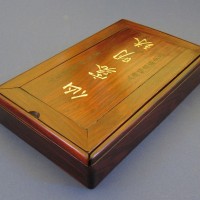
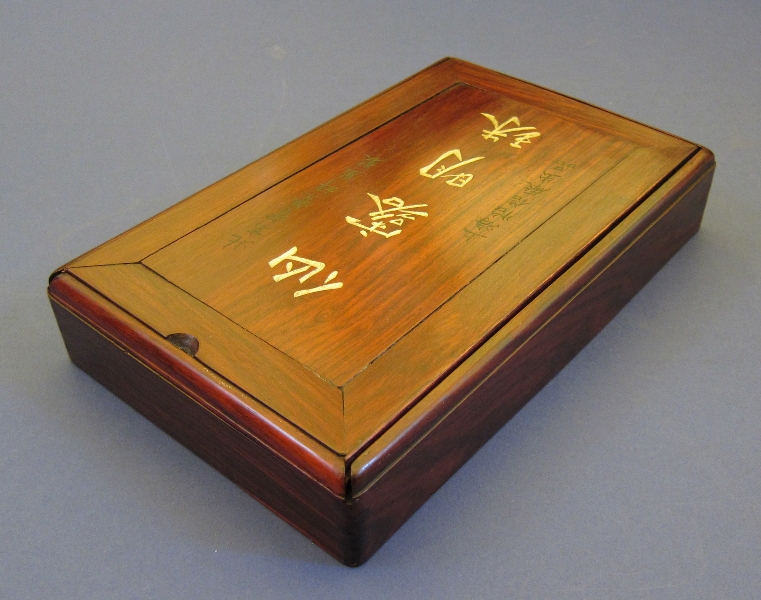
Rectangular box with four large white sinograms and two columns of smaller sinograms painted in green. Slide-top lid.
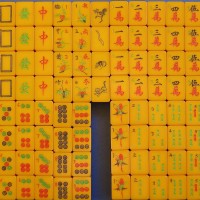
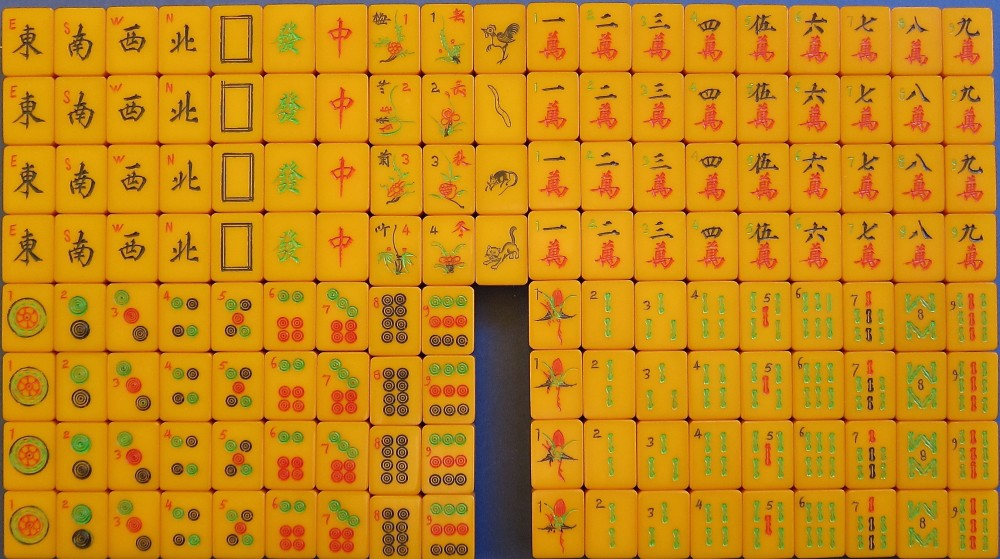
A twelve Flowers synthetic set. Translucent tiles. The tile patterns are similar to the preceding set as are the Flowers.
The 1st column are Plum, Orchid, Chrysanthemum, Bamboo, together with their respective sonograms.
The 2nd column are possibly Narcissus, Lotus, Pomegranate and Peony. The sinograms read Spring, Summer, Autumn and Winter. (See previous caption to the Flowers for an explanation of these symbols).
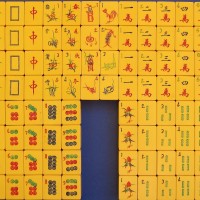
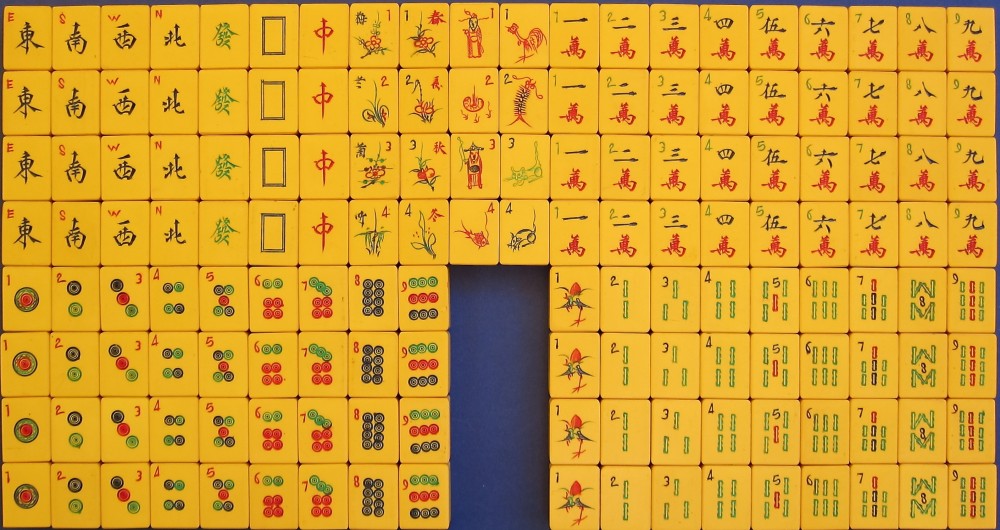
A sixteen Flowers synthetic set probably produced during the 1950's due to the style of the bird and the style of engraving of the human figures.
From the 1st column we have Four Flowers and their sinograms; Plum Blossom, mdi, 梅,; Orchid, lan, 兰; Chrysanthemum, ju, 菊, and Bamboo, zhu, 竹. Thus we have the names of "flowers" referred to as the "Four Gentlemen" or as as the "Four Noble Ones". The Chinese terminology being Si Junzi, 四君子 (The Four Junzi).
The 2nd column; The Flowers have symbolic meaning but it depends on identification of the flower on each tile. In this case some of the engravings are not readily available. The best interpretation we glean are the peony, lotus, pomegranate and narcissus = "May you have longevity (Narcissus) wealth and rank (Peony) an continuously (Lotus) have many sons (Pomegranate)". These are together with the sinograms for Spring, Summer, Autumn and Winter.
In the 3rd column we have a human figure, a gold or silver ingot, a fisherman and a fish (probably a carp). Thus the man attains the ingot and hence wealth, the Fisherman catches the carp (profit) since carp and profit are homophones.
In the 4th column we have a Cockerel, a Centipede, a Cat and a Rat.
The Cockerel and the Centipede;The cockerel is an auspicious bird, in itself signifying good luck, ability and courage. They can also discourage evil spirits. In Feng Shui, it is sometimes suggested that TV antennae, electrical poles and drainage pipes in the surroundings of houses can offer negative energy, as the shape of these objects can look like a Centipede. The ominous chi that emanates from such Centipede-shaped objects is referred to as Wu Gong Sha (蜈蚣煞). (Wu Gong means Centipede and Sha is the negative energy.) the suggested remedy is to place a Cockerel facing the cause of the ominous energy for protection.
A Centipede is one of the "Five Poisonous Creatures" or Wudu, and again the Cockerel fights against them.
However, there is also a Chinese folk story about the Dragon persuading a Centipede to trick the Cockerel in to lending the Dragon his crown. Afterwards the Dragon refuses to give back the crown and the so the Cockerel and Centipede have ever since been enemies, with thereafter, the Cockerel always pecking at the Centipede.
The Cat and the Rat: This may be a straight forward allusion to the attainment of Wealth.
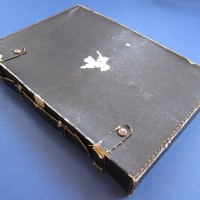
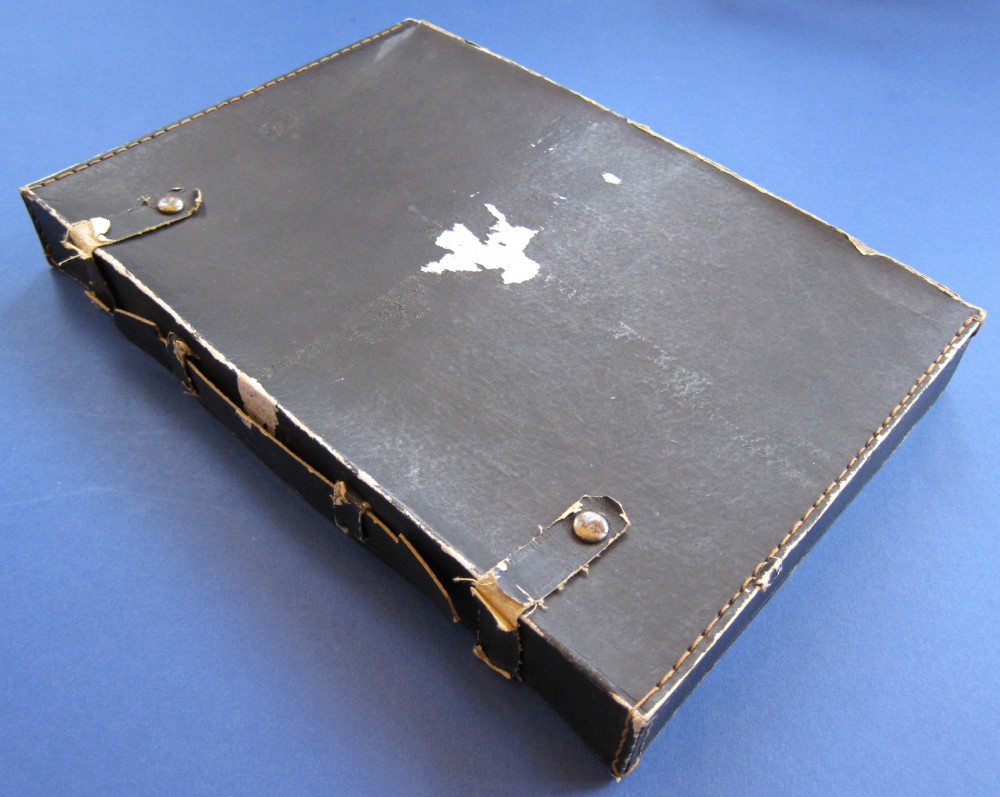
Cardboard attaché-style case. Four Cardboard trays for the tiles and a fifth tray for the game accessories.
Red-stained cabinet with brass bats mounted on the eight corners. Four trays holding the tiles and a fifth tray with four spare blank tiles and accessories.
Two green sinograms on the slide front cover. From right to left: fú and shòu = happiness, good fortune + long life. The brass bats fú are also homophones for fú happiness and good fortune.
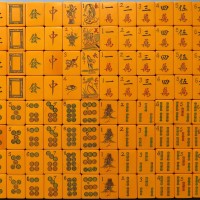
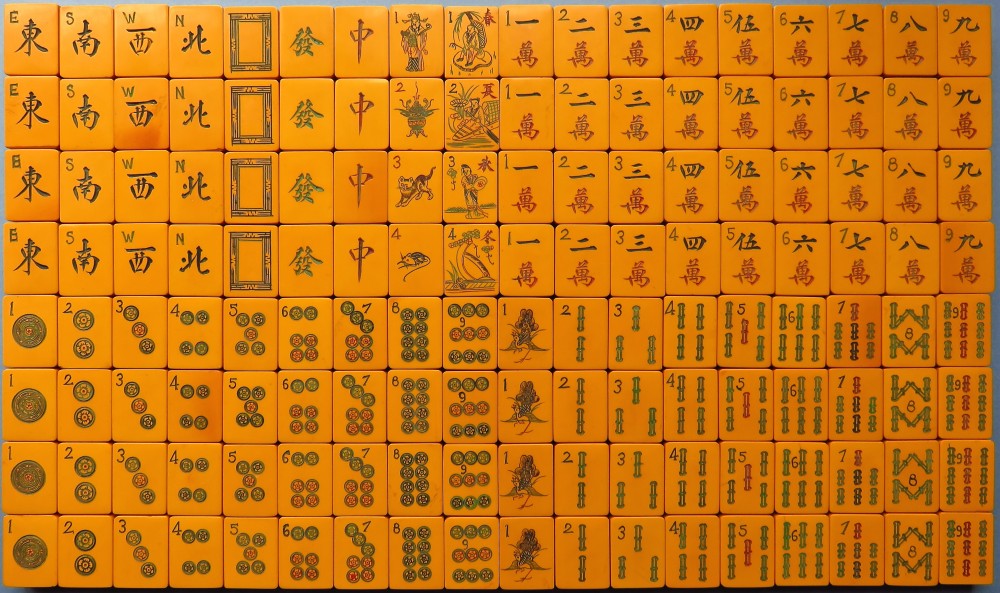
Solid, thick 'Chinese Bakelite' tiles. Preliminary analysis of a similar tile reveals a chemical composition similar to Bakelite.